How to Quickly Make a Resume on Your Phone
Want to quickly apply for a job position while you are on the go? Here's how you can create an attractive resume on your phone.
When applying for a job, your resume plays a big role in deciding whether you get hired or not. It is one of those job-hunting tools that you need to keep in excellent shape.
However, it's not every time you get ample time to prepare a glittering resume for a job opening. You could be on the move, maybe at a metro station or on a bus, when you urgently need to apply somewhere.
In such situations, how can you quickly create a resume that will grab the attention of a hiring manager using your mobile phone?

Is It Okay to Create a Resume With Your Phone?
Although it might seem a bit unprofessional to apply for that big paycheck job from your smartphone, there's nothing wrong with it if you're pressed for time.
If you do things the right way, there's no way for a recruiter to tell whether your resume was created using your mobile phone or from your PC. Even if they somehow find out, as long as it is good enough, no recruiter will be inclined to penalize you.
With the trend of remote work, there's a good chance that a recruiter could be reviewing your resume from a mobile device as well. This means it is a good idea to ensure your resume looks good on mobile as well. What better way to do that than to create it on a mobile device?
3 Easy Ways to Create a Professional Resume on Your Phone
So you're scrolling through social media while in a taxi, and a job opening that's almost past the deadline pops up. How can you apply it from your smartphone?
1. Use a Mobile-Friendly Resume-Building Website
You need your resume to look its best in design and be presented using the best possible wordings. Unfortunately, if you're pressed for time, creative words may not be forthcoming. Using a mobile-friendly resume website is one of the fastest ways to put up a well-rounded resume with minimal input from your end.
- Resume.com is one of the fastest websites to build a professional resume, and it's free. All you need to do is to create an account, select a resume template, edit your professional data, and you're ready. You can still use the website without wasting time with registration. Once you're done editing your data, your resume is sent immediately to your email address.
- Resumegenius is another popular option for building your resume in minutes. You'll find a lot of beautiful resume templates and an AI-powered resume builder that suggest relevant bullet points to use depending on what kind of job you're applying for. However, you might need to pay a $2.95 monthly subscription to download the resume.
- Zety is another powerful web-based resume builder. Apart from your personal information, you don't have to write anything from scratch. You'll find a lot of pre-written points tailored to reflect the personal information you provide. You can set up a well-worded and well-designed resume in a few minutes. Although you can preview your finished resume, you'll have to pay to download it.
- Wozber is a free professional resume builder with a handful of beautiful templates to choose from. Its free model cuts off the extra time you'd typically spend to make payments before downloading your resume. Its simple user interface leads you straight to building your resume—no marketing gimmicks, no time-wasters.
- EnhanCV is another free option that offers extensive customization features. Although there are hundreds of pre-written templates for different job positions, every part of each template can be customized. You can create and download an excellent resume in under 15 minutes.
VisualCV , Kickresume , and Novoresume are also among some of the best resume builder websites to help you put up a resume in a short time.
2. Use a Resume Builder App
These days, you can find a mobile app for almost everything you can do online, and resume-building apps are not an exception. Whenever there's an urgent need, there are a lot of reliable mobile apps you can use to create a resume on the move.
Canva is a choice of millions of people and one of the most reliable resume builder apps you can use for free. It offers a lot of highly customizable templates, and it's quite easy to use.
Download: Canva Android | iOS (Free, Subscription available)
CV Engineer is another good option that offers impressive flexibility and is relatively easy to use. Once you download the app, you can put up a professional CV in a few minutes.
Download: CV Engineer Android | iOS (Free, Subscription available)
Resumaker is a good option if you want a resume builder that can help you craft a colorful and professional resume that can immediately appeal to recruiters.
Download: Resumaker Android | iOS (Free)
If you'd prefer to build your resume from scratch without using any special resume builder, here's a guide on how to build a professional resume using Google Docs .
3. Download Your Indeed Profile as a Resume
If you've completed setting up your Indeed profile with your personal and professional data, the fastest way to get a resume is to download a copy of your profile. If you choose to follow this route, you can get a professional resume within 1 minute.
The downloaded profile will be properly formatted as a resume, typically including all relevant professional information that you've included on your profile. To access your Indeed resume on mobile:
- Sign in to your Indeed account
- Tap the menu icon in the top right corner
- Scroll down and locate Profile and tap on it
- On the next page, click on Indeed Resume and edit any information you'd love to change.
- Click on the three dots icon in the top right corner of your browser screen (next to the button labeled Private ), and tap on Download my Indeed Resume .
Your Smartphone Can Do the Trick
Whether your personal computer is inaccessible or you do not have one at all, you can still create a resume that appeals to recruiters right from your mobile phone. As long as you use the right tools and provide the needed data, the quality of the finished resume will not be compromised.
So, next time you're in a hurry to create a resume for a job offer, you don't have to rush home to get your PC. The smartphone in your pocket can do the job efficiently.
Search results for
Affiliate links on Android Authority may earn us a commission. Learn more.
10 best resume builder apps for Android
Published on March 22, 2024
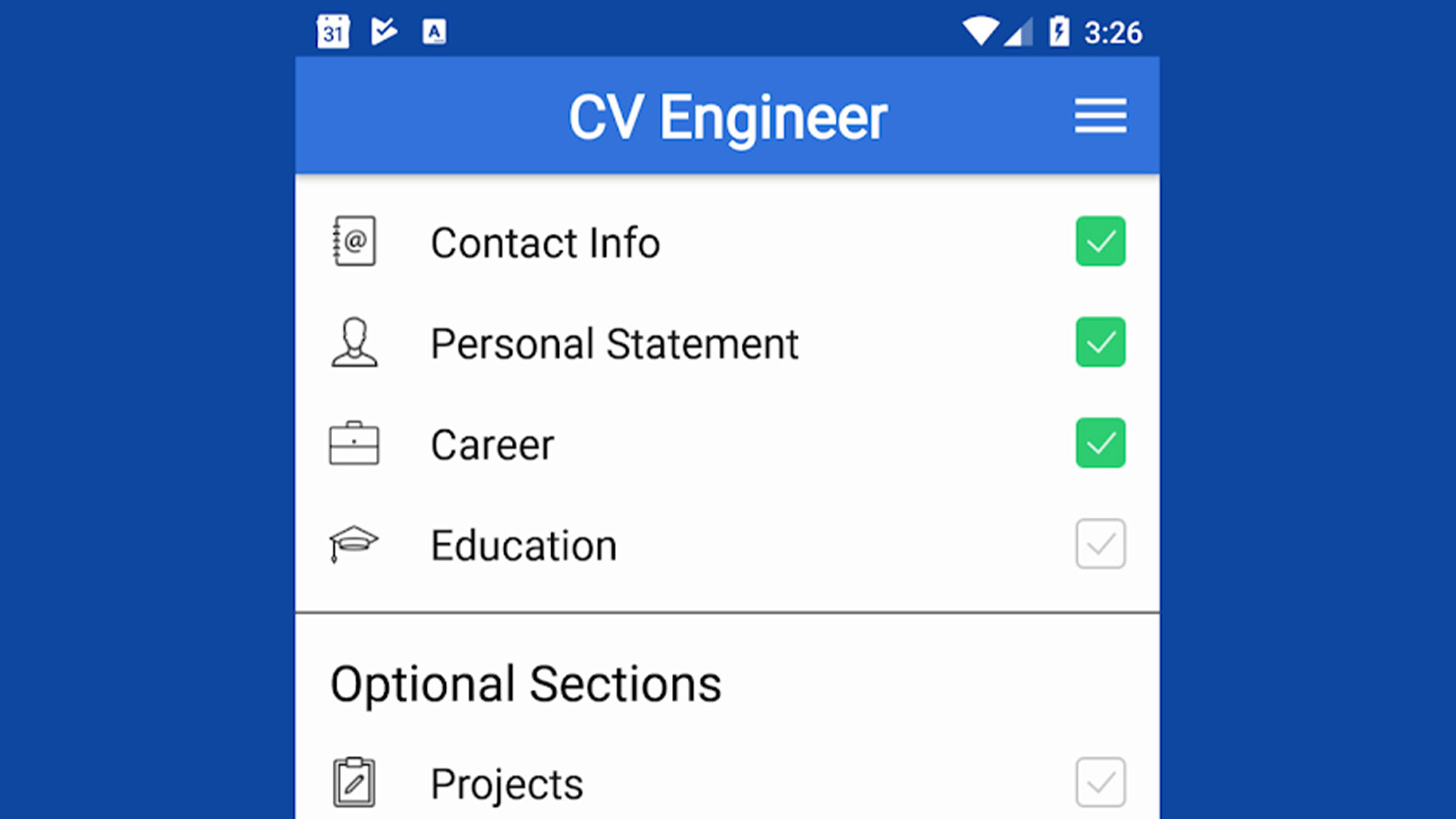
Job searches are already fairly stressful. You should be able to build a resume without adding to that stress. Resumes are important because they give you a single document that you can send to multiple employers. It has your contact information, job history, references, and all kinds of valuable information for employers. It’s way easier to hand out a well-made resume than it is to fill out dozens of applications. Additionally, many jobs require both an application and a resume anyway, and it’s always good to be prepared. Here are the best resume builder apps for Android. Of course, many of these are useful for CVs for you academics out there.
The best resume builder apps for Android
Cv engineer, free resume builder, microsoft word, professional resume builder, resume builder app, resume builder free cv maker.
- Many job search apps
Price: Free /In-app purchases ($2.49 – $22.49 per item)
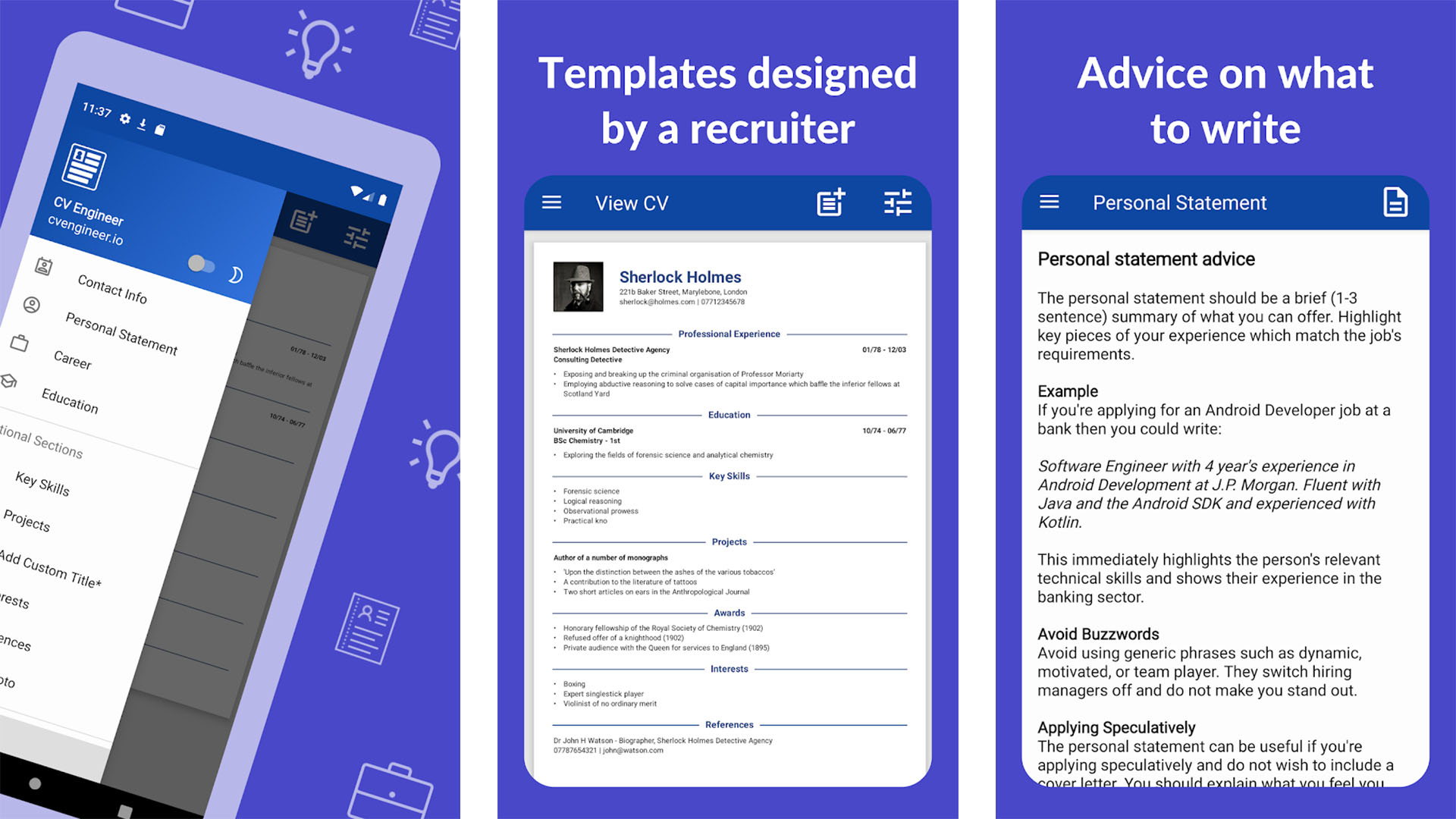
CV Engineer is a popular app in this space. It features a bunch of resumes and has really simple controls; you can export them in PDF format when you’re done. You simply fill out each field until the whole thing is finished, so it’s easy enough for just about anyone to use. The app was also designed by a recruitment consultant, so the templates are reasonably decent for just about anything. You can make resumes and CVs for free and contribute later if you want to.
Price: Free /In-app purchases ($2.49 per item)
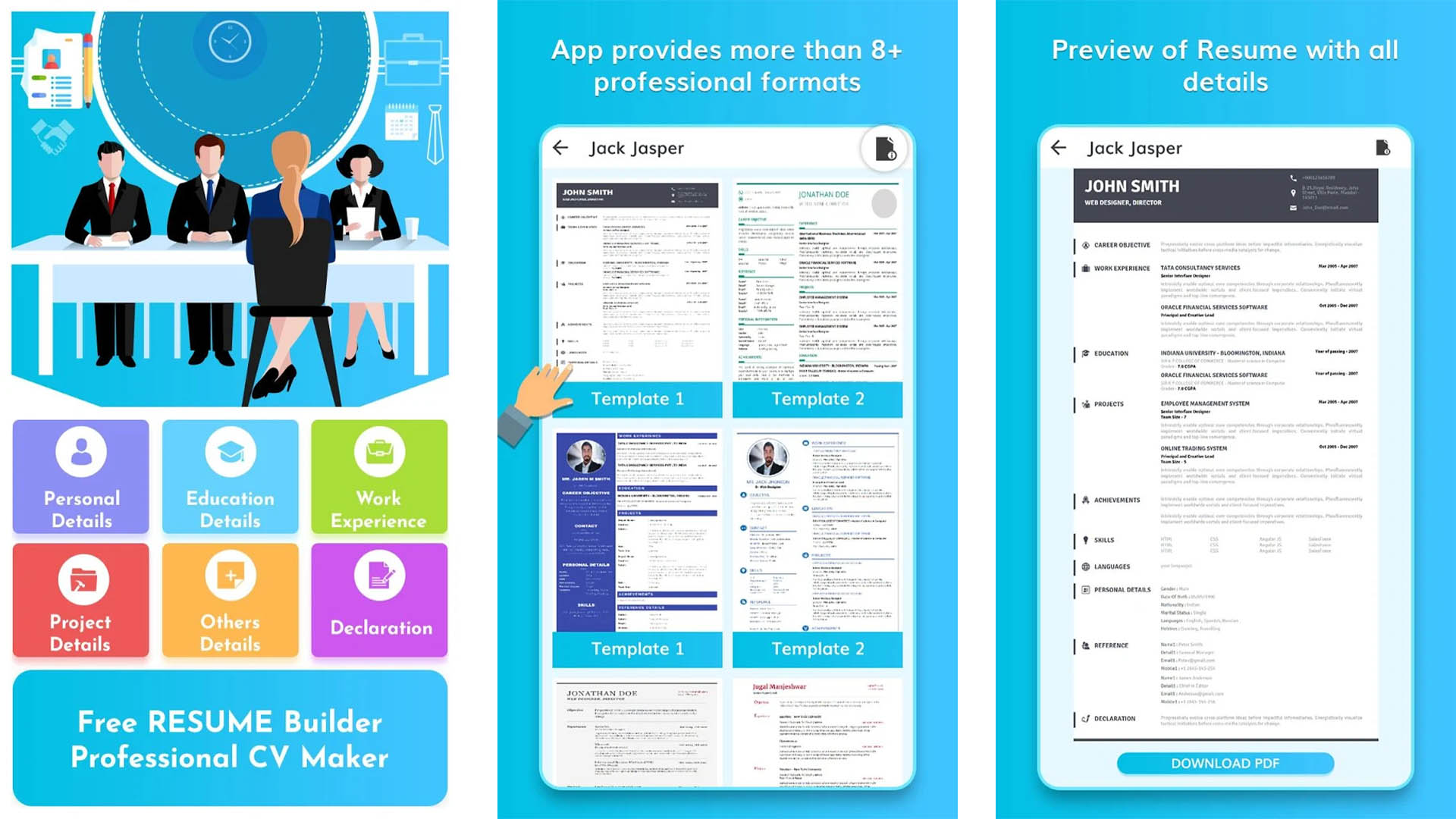
Free Resume Builder by Magnetic Lab is one of the better free resume builder apps on our list. It has a bunch of customizable sections for whatever kind of resume you want to build. This includes an advanced resume editor where you can reformat the template to your liking. Some other features include PDF format support and the ability to duplicate resumes. We quite liked the UI and information input with this one. It’s super easy to use, and the UI is very user-friendly. You can pay $2.49 as an in-app purchase to remove ads.
Price: Free /In-app purchases ($29.99 – $323.88 per item)
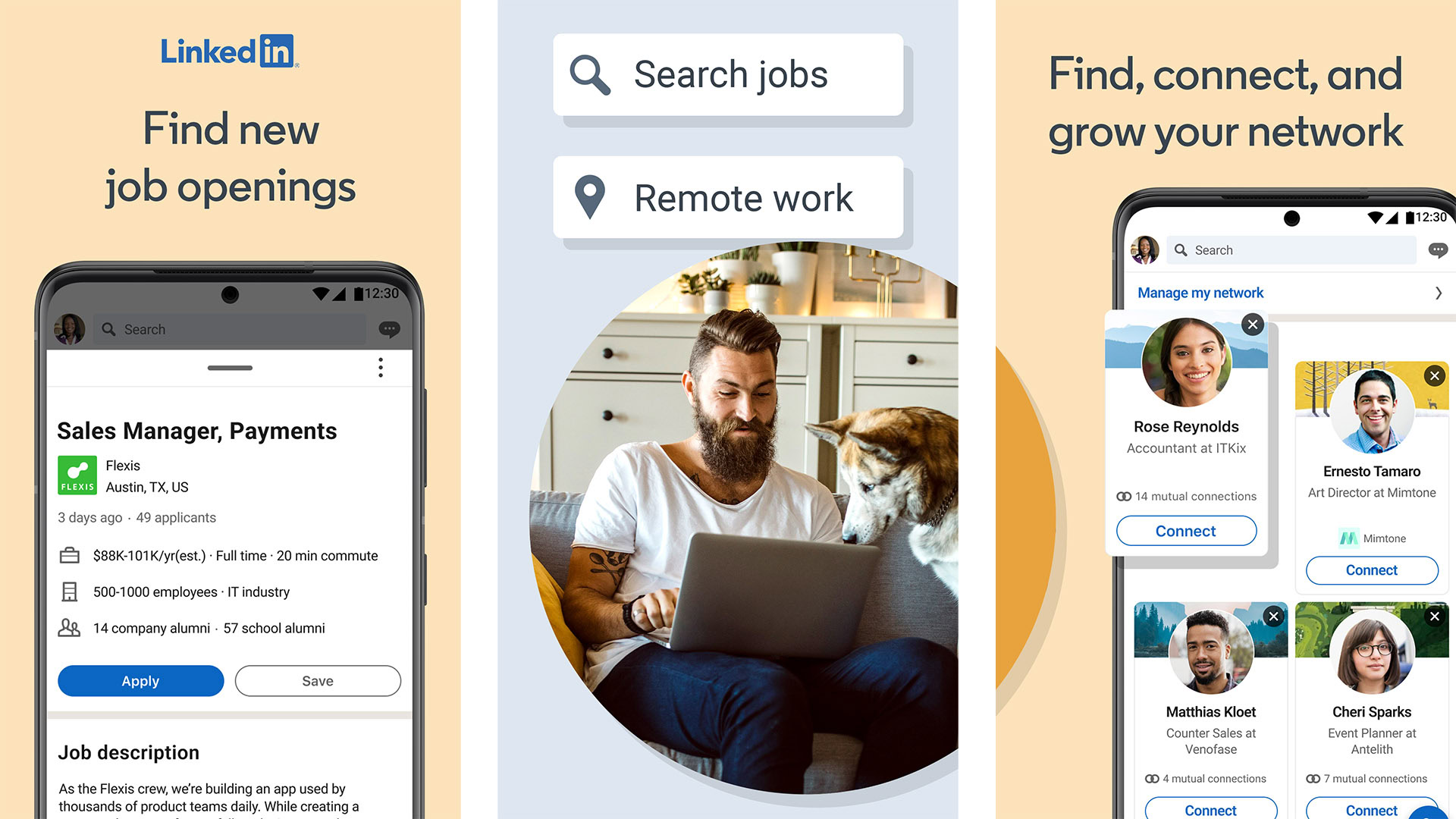
Everybody knows about LinkedIn. The service is a mix of social media and a job-searching website. It’s also a source of information for various types of professionals. Your profile is basically your resume. You put your background, job experience, and education experience there. People can then connect with you, or you can apply for jobs right there on the site. It has its ups and downs, both in popularity and functionality. However, it’s easily the largest website on the Internet that does what this app does. LinkedIn also has an excellent professional learning app called Linked Learning if you want to brush up on some job skills.
Price: Free /In-app purchases ($1.00 – $99.99 per item)
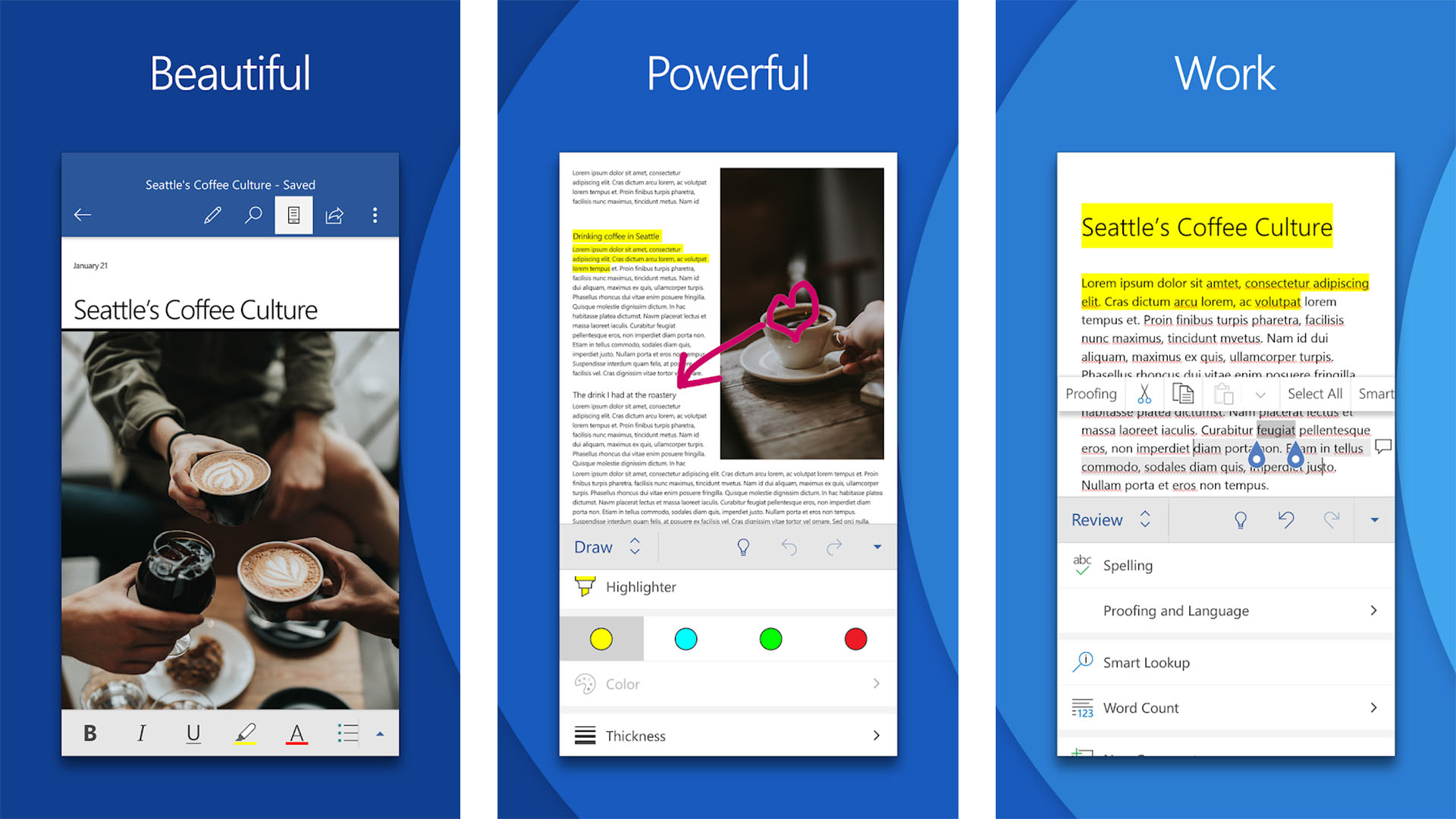
Microsoft Word is the original resume builder app. People still use this app to build a resume. The app has templates, and it leverages its word processing capabilities to generate some really neat-looking stuff. You can export in a variety of formats, including Word’s native format or PDF if you choose. The mobile version doesn’t have a ton of available templates, but it has a good basic option. You’ll likely have more luck on the web version or the desktop version if you have access to those.
Price: Free
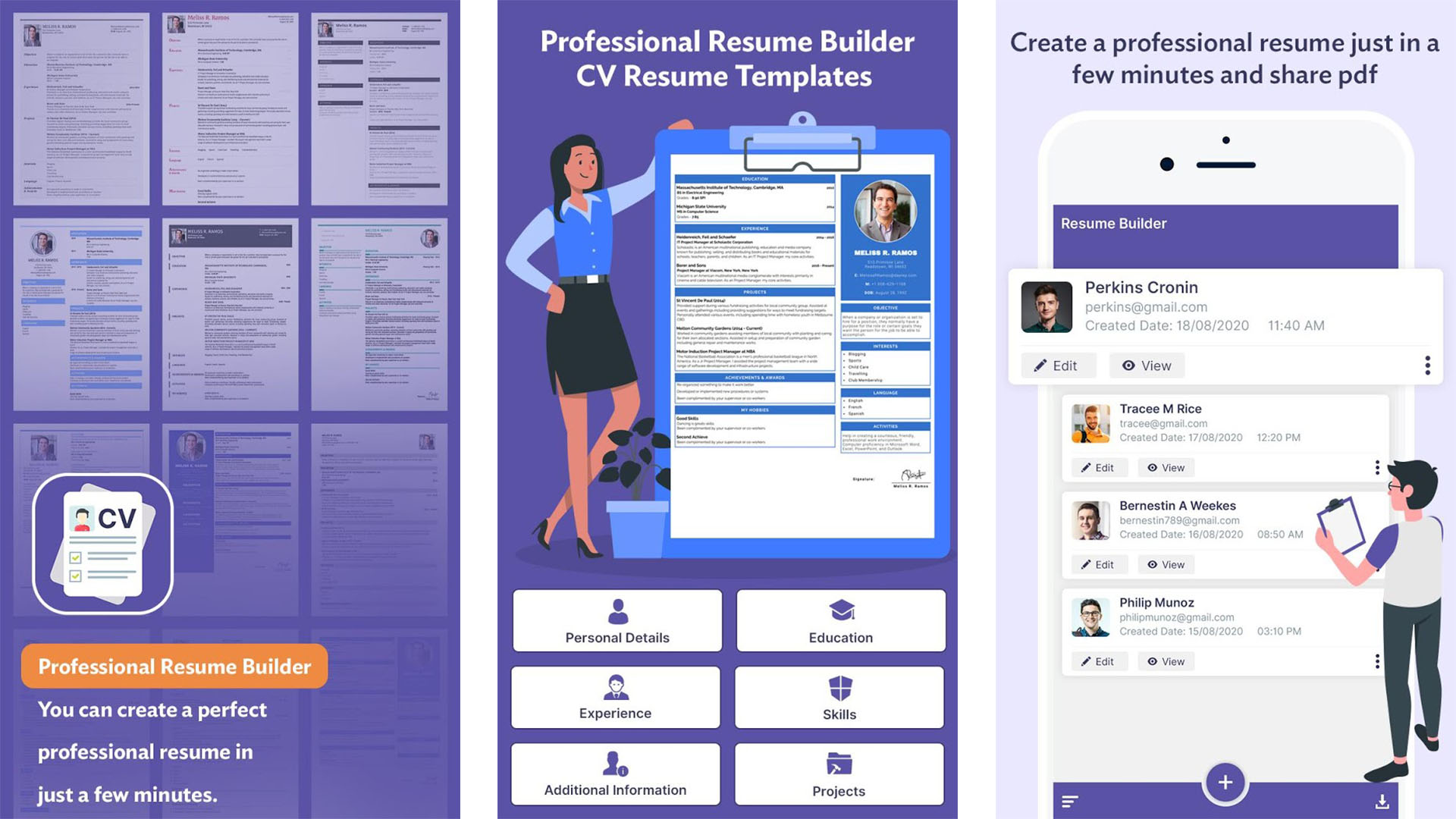
Professional Resume Builder is a decent resume app. You can customize your resume with a bunch of things, including more niche stuff like multiple languages, publications, and your picture and signature. You can even create custom sections if you want to. The app is entirely free to use with ads, and you can pay to remove the advertising. It’s nice to see things kept simple. It exports to PDF as per the norm, and the editor is fairly easy to use once you get the hang of it.
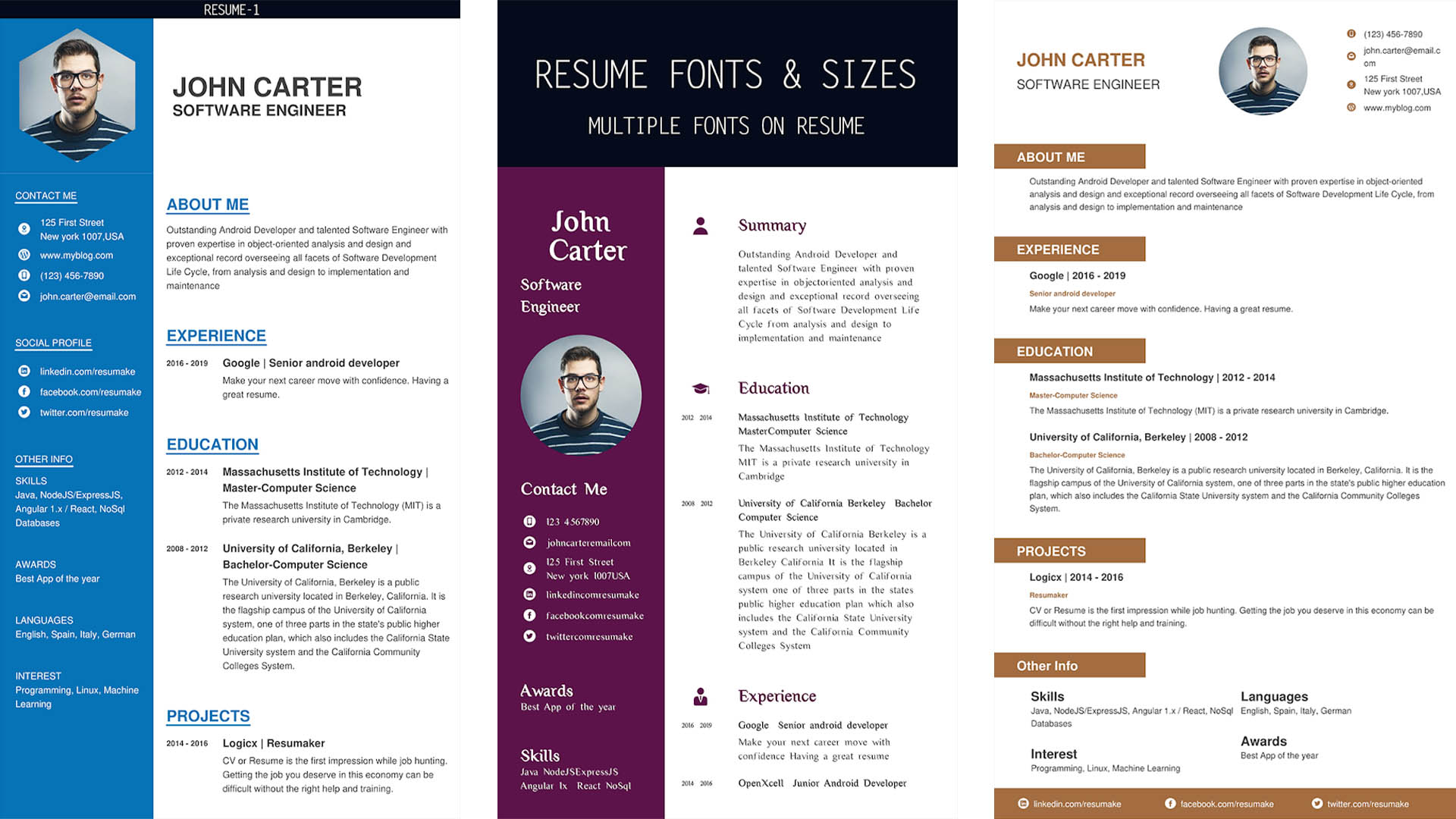
Resumaker is an up-and-coming resume-building app. It covers all of the usual bases. You can do both resumes and CVs with it; there are multiple templates for each, and it’s easy enough to fill one out and export it. You can customize every letter of your resume if you need to, and you can even make it colorful if you want. It exports to PDF format, as most do. The templates look clean for the most part as well. The app is entirely free, with ad support. There are some complaints about some minor bugs, but nothing major.
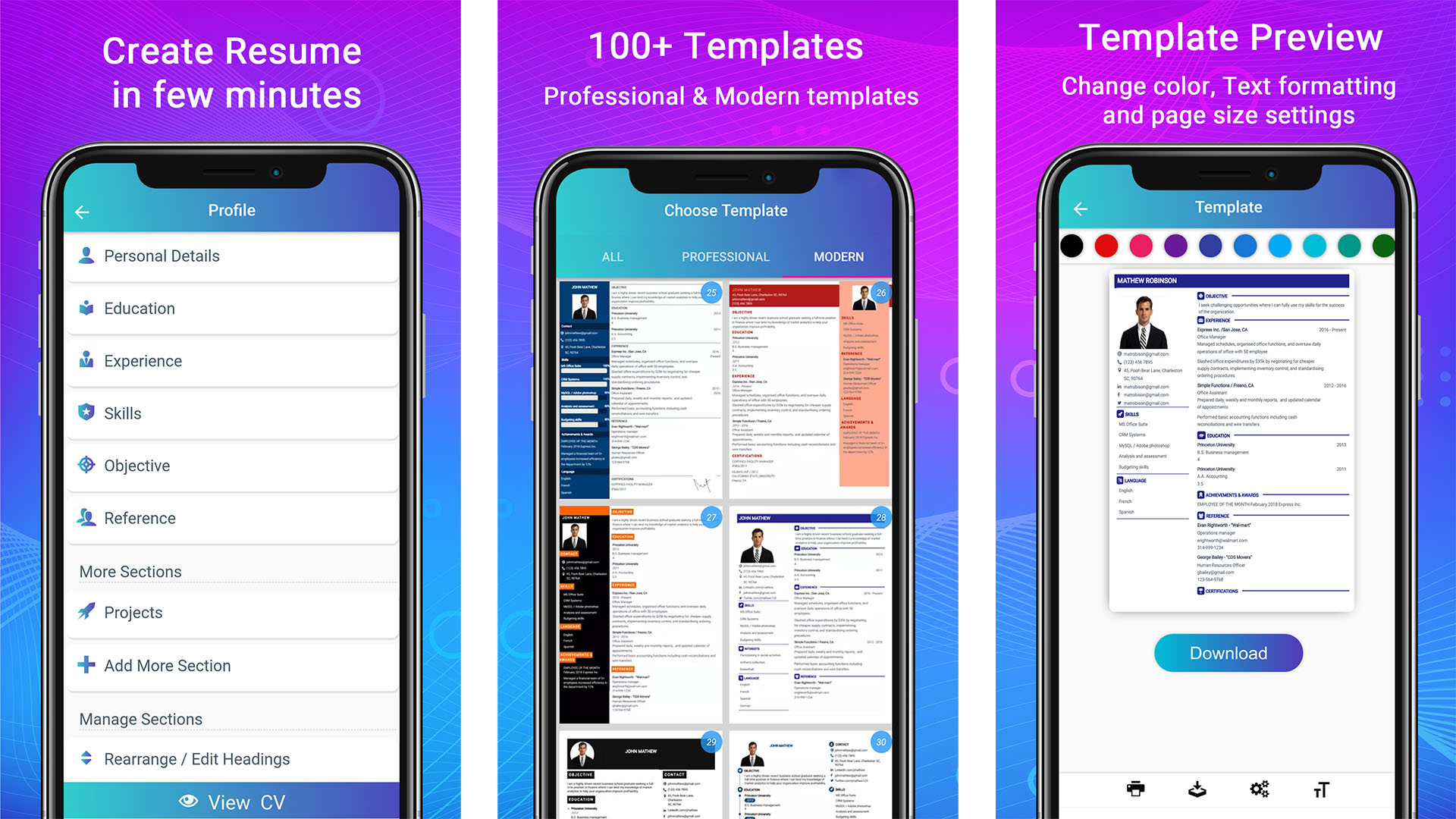
Resume Builder App by Intelligent CV is another reasonably competent resume builder app. The app boasts hundreds of templates for both resumes and CVs. Additionally, it exports to PDF as usual, includes a cover letter, and you can add photos of yourself if you want to. It does all of the basics right. The app is totally free and supported by advertisements. That makes it a good bargain for folks who can’t afford it right now. Plus, the UI and the live editor are both pretty good too.
Price: Free /In-app purchases ($0.99 – $99.99 per item)

Resume Builder Free CV Maker does precisely what its name says. It boasts over 50 templates for both resumes and CVs. You also get an auto-save function, multiple resumes, PDF support, email support, and it’s relatively customizable. You should be able to find all of the tools to make a decent resume or CV with this app. Some complain about the frequency of the ads, but it’s a free app, so it’s difficult to complain too much. There really isn’t anything flashy about it. It just makes resumes.
Price: Free /In-app purchases ($0.99 – $7.99 per item)
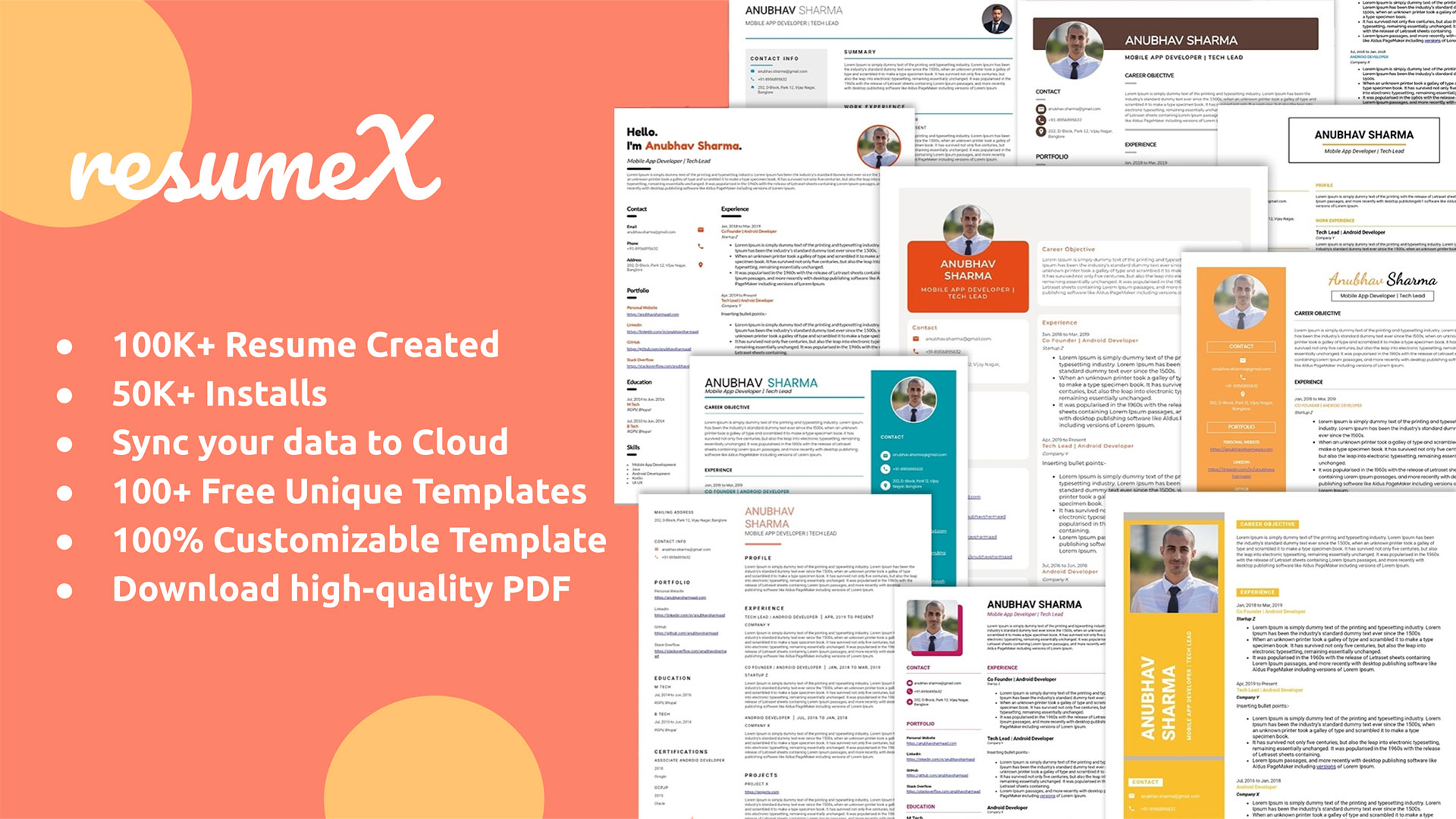
ResumeX is a clean, functional resume builder app with enough features for most folks. It comes with a bunch of templates that you can unlock for free if you don’t mind watching ads. From there, it’s mostly just data entry as you enter your credentials and information. There are also some light customization options to help your resume stand out. The app is free to use, with ads. Watching ads gives you credits that you can use to unlock templates. You can also buy the lifetime unlocked version for $7.99 and get everything.
Job Search apps
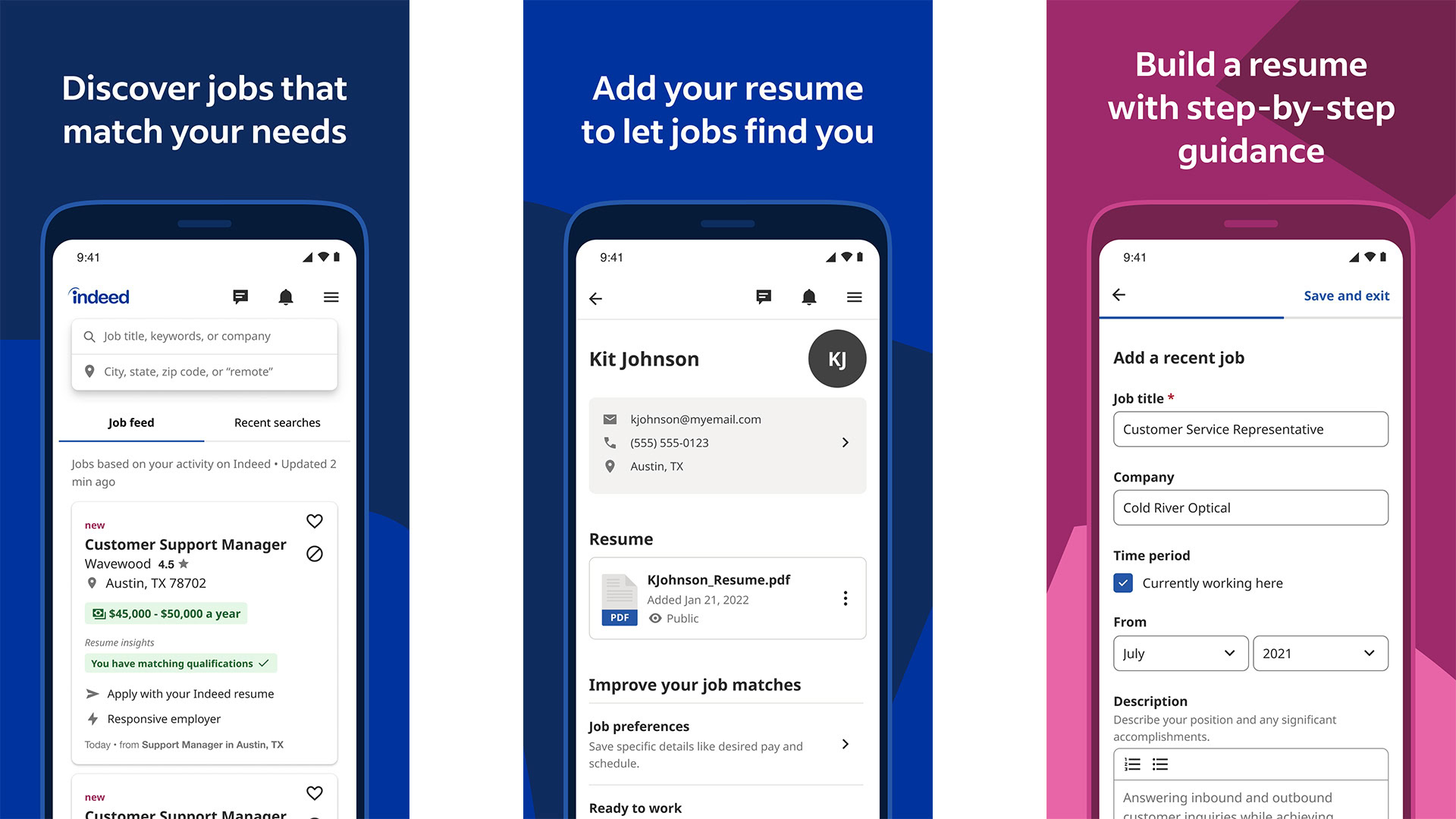
Many job search apps have resume builders as part of the app itself. One such example is Indeed Job Search. Most job search apps don’t advertise a resume builder, but about half of them actually have one. This is a good option for finding a job because you can create your resume and immediately turn around and find potential employers to send it to. Of course, this locks you into that job search app’s ecosystem, but as long as you find a job, it doesn’t matter that much, right? We have Indeed linked up at the button below, but there are dozens of them on Google Play.
If we missed any great resume builder apps or any great CV apps, tell us about them in the comments. You can also click here to check out our latest Android app and game lists .
You might like
How to Make a Resume in 2024 | Beginner's Guide

For most job-seekers, a good resume is what stands between a dream job and Choice D. Get your resume right, and you’ll be getting replies from every other company you apply to.
If your resume game is weak, though, you’ll end up sitting around for weeks, maybe even months, before you even get a single response.
So you’re probably wondering how you can write a resume that gets you an interview straight up.
Well, you’ve come to the right place!
In this guide, we’re going to teach you everything you need to know about how to make a resume, including:
- The 8 Essential Steps to Writing a Resume
- 11+ Exclusive Resume Tips to Up Your Resume Game
- 27+ Real-Life Resume Examples for Different Professions
….and more!
So, let’s dive right in.

How to Make a Resume (The Right Way!)
Before we go into detail about how you should make a resume, here’s a summary of the most important steps and tips to keep in mind:

- Choose a resume format carefully. In 99% of cases, we recommend the reverse-chronological format .
- Add the right contact details. Leave your headshot out and make sure to include your job title , a professional email address, and any relevant links. (E.g.: your LinkedIn profile , online portfolio, personal website, etc.).
- Write an impactful resume summary. Unless you’re an entry-level professional, always go for a resume summary. If you do it right, it’s your chance to get the hiring manager to go through the rest of your resume in detail.
- Pay attention to your work experience section. Take your work experience section from OK-ish to exceptional by tailoring it to the job ad, making your achievements quantifiable, and using action verbs and power words.
- Add the right skills for the job. Keep this section relevant by only including the hard and soft skills that are required for the position.
- Keep your education short and to the point. Your most recent and highest degree is more than enough for a strong education section. You only need to add more details here if you’re a recent graduate with barely any work experience.
- Leverage optional resume sections. Optional sections like languages, hobbies, certifications, independent projects, and others can set you apart from other candidates with similar skills and experience.
- Include a cover letter. That’s right, cover letters matter in 2024, and the best way to supplement your resume is by adding an equally well-crafted cover letter to your job application. To make the most of it, check out our detailed guide on how to write a cover letter .
To get the most out of our tips, you can head over to the resume builder and start building your resume on the go as you read this guide.
New to resume-making? Give our ‘7 Resume Tips’ video a watch before diving into the article!
#1. Pick the Right Resume Format
Before you start filling in the contents of your resume, you have to make sure it’s going to look good.
After all, the first thing hiring managers notice is what your resume looks like, and then they start reading it. So, this is your best chance to make a great first impression.
Start by choosing the right resume format.
There are three types of resume formats out there:
- Reverse-chronological. This is by far the most popular resume format worldwide and, as such, it’s the best format for most job-seekers.
- Functional. This resume format focuses more on skills than work experience. It’s a good choice if you’re just getting started with your career and have little to no experience in the field.
- Combination. The combination resume format is a great choice for experienced job-seekers with a very diverse skill set. It’s useful if you’re applying for a role that requires expertise in several different fields and you want to show all that in your resume.
So, which one should you go for?
In 99% of cases, you want to stick to the reverse-chronological resume format . It’s the most popular format and what hiring managers expect to see. So, in the rest of this guide, we’re going to focus on teaching you how to make a reverse-chronological resume.

Fix Your Resume’s Layout
With formatting out of the way, let’s talk about your resume’s layout , which determines the overall look of your resume.
Does it look organized or cluttered? Is it too short or too long? Is it boring and easy to ignore, or is it reader-friendly and attention-grabbing?
Here are some of the best practices you should apply:
- Stick to one page. You should only go for a two-page resume if you have decades of experience and you’re sure the extra space will add significant value. Hiring managers in big companies get hundreds of applications per job opening. They’re not going to spend their valuable time reading your life story!
- Add clear section headings. Pick a heading and use it for all the section headers so the hiring manager can easily navigate through your resume.
- Adjust the margins. Without the right amount of white space, your resume will end up looking overcrowded with information. Set your margins to one inch on all sides so your text fits just right on the page.
- Choose a professional font. We’d recommend sticking to a font that’s professional but not overused. For example, Ubuntu, Roboto, or Overpass. Avoid Times New Roman, and never use Comic Sans.
- Set the correct font size. As a rule of thumb, go for 11-12 pt for normal text and 14-16 pt for section titles.
- Use a PDF file. Always save your resume as a PDF file, unless the employer specifically requests otherwise. Word files are popular, but there’s a good chance they’ll mess up your resume’s formatting.
Another thing you need to consider in terms of your resume’s layout is whether you’re going for a traditional-looking resume template or something a bit more modern :
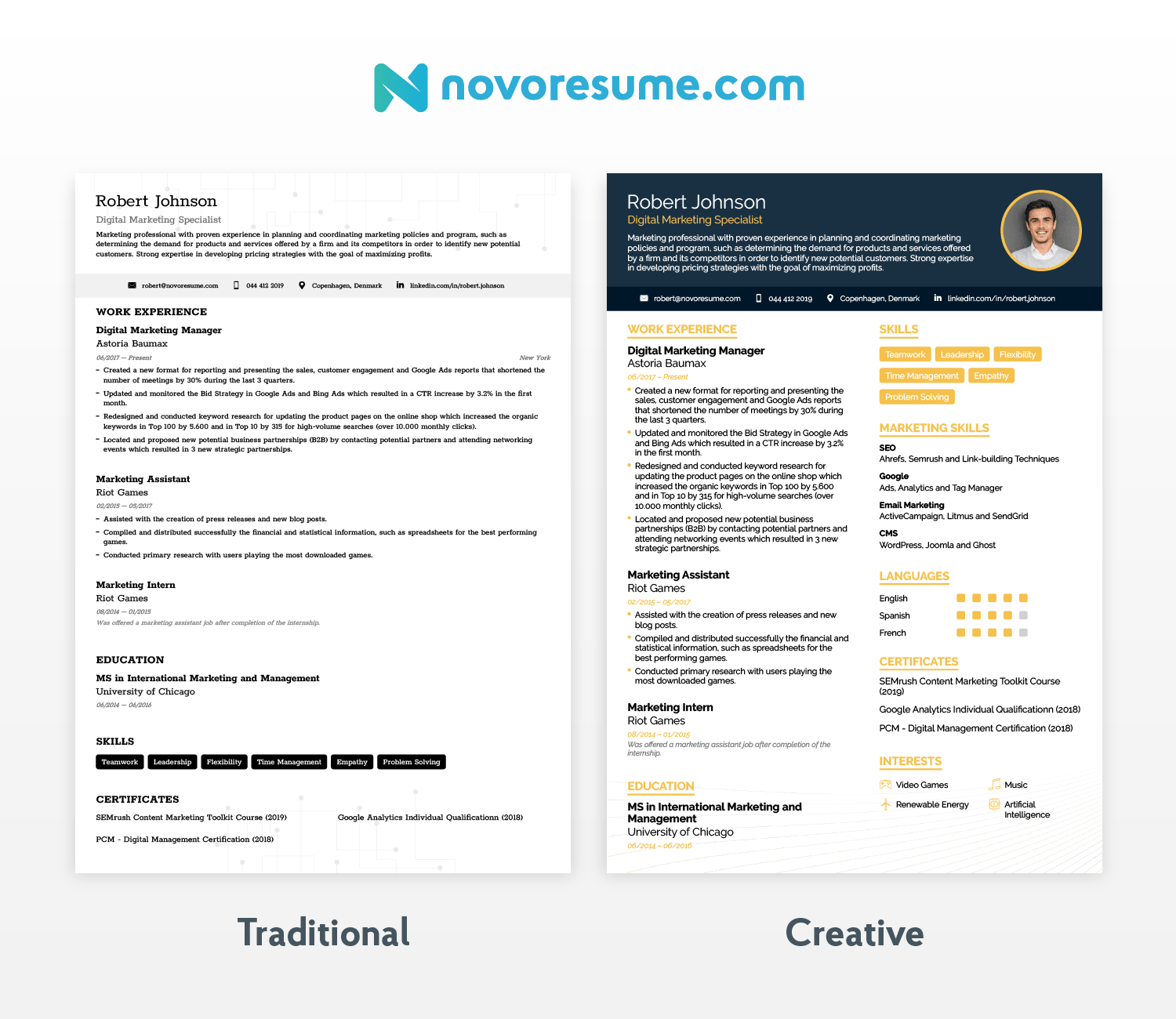
If you’re pursuing a career in a more traditional industry, like law , banking , or finance , you might want to stick to the first.
But if you’re applying to a tech company where imagination and innovation are valued, you can pick a more creative resume template .
Want to Save Time? Use a (Free) Resume Template
Anyone who’s ever tried creating a resume from scratch knows how boring the formatting can be.
Before you can even start filling in the contents, you need to tweak the margins, adjust font sizes, and make sure everything fits into one page while still looking good.
What if you could skip past all that and still create a compelling resume?
Try one of our free resume templates . They’re pre-formatted, so all you have to do is fill in the contents.
They’re also created in collaboration with recruiters from around the globe, ensuring that the templates are visually appealing and ATS-friendly!
See for yourself how one of our templates compares to a resume created in a standard text editor:

#2. Add Your Contact Information
Now that we’ve got all the formatting out of the way, let’s get into what your resume is all about— the information you put on it .
The first thing you want to do when filling out the contents of your resume is to add your contact information .
This section is pretty straightforward but crucial. Your contact details belong at the top of your resume in a designated resume header , so the hiring manager can easily find them.
Even if everything else about your resume is perfect, that all flops if you misspell your email address or have a typo in your phone number. If the hiring manager can’t contact you, it’s a missed opportunity.
So, double-check, and even triple-check your contact information section and make sure everything is factually correct and up-to-date.
Must-Have Information
- Full name. Your first and last name should stand out at the top of your resume.
- Email address. Stick to an address that’s professional and easy to spell, like a combination of your first and last name. (E.g.: [email protected])
- Phone number. Add a reliable number where the hiring manager can easily reach you.
- Location. Add your city and state/country. If you plan to relocate for the job or want a remote position, specify it on your resume.
Optional Information
- Job title. Add your professional title underneath. Write it down word for word, whether it’s “Digital Marketing Specialist” or “Junior Data Scientist.” Just don’t make up job titles like “Marketing Wizzard” or “Data Manipulator.” They’re not quirky; they’re just unprofessional.
- LinkedIn profile . We recommend that you include a link to your updated LinkedIn profile since over 77% of hiring managers use the platform when evaluating a candidate.
- Relevant links. Include links to personal websites or any social media profiles that are relevant to your field. For example, a developer could include a Github profile, while a graphic designer could link their Behance or Driblle account, and so on.
- Date of birth. Unless this is specifically required in the job ad, the hiring manager doesn’t need to know how old you are. It’s not important for their decision-making, and at worst, it might lead to age-based discrimination.
- Unprofessional email address. Your quirky, old high school email address doesn’t belong on your resume. Instead of [email protected] , go for a [email protected] type of address.
- Headshot. (USA, UK or Ireland) Depending on the country where you’re applying, it might even be illegal to include a picture of yourself on your resume . While it’s the norm to include a picture in most of Europe and Asia, always check the regulations for each specific country or industry you’re applying to.
All clear? Good! Now, let’s look at what a great example of a resume's contact information section looks like:

#3. Write a Resume Headline (Summary or Objective)
It's no secret that recruiters spend an average of less than seven seconds on a resume .
When you receive hundreds, if not thousands, of applications daily, it's physically impossible to spend too much time on each.
So, what the hiring managers do to go through resumes more effectively is to skim through each resume and read it in depth only if it piques their interest.
This is where the resume headline comes in.
Placed right next to (or underneath) your contact information, this brief paragraph is the first thing the hiring manager is going to read on your resume.
Now, depending on how far along in your career you are, your resume headline can be either a resume summary or a resume objective.

So, how do you choose between a resume summary and a resume objective? Here’s all you need to know:
Resume Summary
A resume summary, as the name suggests, is a two to three-sentence summary of your career so far. If done right, it shows that you’re a qualified candidate at a glance and gets the hiring manager to give you a chance.
Here’s what your resume summary should include:
- Your job title and years of experience.
- A couple of your greatest professional achievements or core responsibilities.
- Your most relevant skills for the job.
Here’s an example of a well-written resume summary:
Experienced Java Developer with 5 years of experience in building scalable and efficient applications. Contributed to a major project that enhanced application performance by 25%. Strong background in Spring Framework and microservices. Aiming to apply robust coding skills to develop innovative software solutions at XYZ Tech Solutions.
Unless you’re a recent graduate or amid a career change, we recommend you stick to a resume summary. Otherwise, a resume objective might be a better option for you.
Resume Objective
A resume objective is supposed to express your professional goals and aspirations, academic background, and any relevant skills you may have for the job.
It communicates your motivation for getting into a new field, so it’s the go-to headline for recent graduates and those going through a career change. As with a resume summary, a resume objective should be brief—around two to four sentences long.
So, here’s what it would look like if you’re a student:
Hard-working recent graduate with a B.A. in Graphic Design from New York State University seeking new opportunities. 3+ years of practical experience working with Adobe Illustrator and Photoshop, creating illustrations and UX/UI design projects. Looking to grow as a designer and perfect my art at XYZ Design Studio.
Or, on the other hand, if you’re going through a career change, it might look more like this:
IT project manager with 5+ years of experience in software development. Managed a team of developers to create products for several industries, such as FinTech and HR tech. Looking to leverage my experience in managing outsourced products as a Product Owner at Company XYZ.
#4. Prioritize Your Work Experience
The most important part of your resume is your work experience.
This is where you get to sell yourself and show off your previous accomplishments and responsibilities.
If you manage to master this section, you’ll know most of what’s there to know about how to make a resume.
There are plenty of good practices for writing your work experience . But before we dive into all the nits and grits, let's start with the basics.
The standard format for each work experience entry is as follows:
- Job title/position. Your job title goes on top of each work experience entry. When the hiring manager looks at your resume, you want them to know, at a glance, that you have relevant work experience for the job.
- Company name/location/description. Mention the name of the employer and the general location, such as the city and state/country where you worked. In some cases, you may also want to briefly describe the company, like when the organization isn’t particularly well-known.
- Dates employed. Add the approximate timeframe of your employment at each company. You don’t need to give exact dates since the standard format for this is mm/yyyy.
- Achievements and responsibilities. This is the core of each work experience entry. Depending on your field, you want to list either your achievements or responsibilities. List them in bullet points instead of paragraphs, so they’ll be easier to read.
Here’s a real-life example:

Your work experience entries should always be listed in reverse chronological order , starting with your most recent job and working your way back into the past.
Now that you know how to list your experience, we’re going to show you how to write about it in a way that makes you stand out from the competition, starting with:
Are you a student with no work experience? We’ve got you covered. Check out our guide to writing a resume with no experience here.
Focus on Achievements Whenever Possible
One of the most common resume mistakes is only listing responsibilities in your work experience section.
Here’s the thing—in most cases, the hiring manager knows exactly what your job responsibilities are.
For example, if you’re a sales manager, your responsibilities would be:
- Reach out to potential clients over the phone or email.
- Maintain relationships with existing company clients and upsell relevant products.
- Tracking and reporting on leads in CRM.
Coincidentally, this is also the same list of responsibilities for every sales manager out there. So, 90% of all other resumes probably mention the same thing.
To stand out from the competition, you want to focus on writing achievements in your resume instead. These can be how you helped your previous company grow, reach quarterly quotas, and so on.
Let’s compare how responsibilities hold up next to achievements for the same job:
- Exceeded sales team KPIs by 30%+ for 3 months straight.
- Generated over $24,000 in sales in 1 month.
- Generated leads through cold-calling
- Managed existing company clients
Keep in mind, though, that in some fields, there just aren’t that many achievements you can mention. Let’s say you’re a warehouse worker .
Your day-to-day responsibilities probably include:
- Loading, unloading, and setting up equipment daily.
- Packaging finished products and getting them ready for shipping.
- Assisting in opening and closing the warehouse.
In fields like this, it’s pretty hard to distinguish yourself through achievements, so it’s okay to stick to responsibilities instead. You can still make them shine by following the rest of our advice about listing your work experience.

Keep in mind, though, that in some fields, there aren’t that many achievements you can mention. Let’s say you work in a warehouse. Your day-to-day responsibilities probably involve:
- Loading, unloading and setting up equipment on a daily basis.
- Package finished product and get it ready for shipping.
- Assist in opening and closing the warehouse.
In such fields, it’s pretty hard to distinguish yourself, so it’s totally OK to stick to responsibilities instead.
Tailor Your Resume to the Job
Tailoring is what sets an amazing resume apart from an okay one.
Hiring managers don’t need to know about every single job you’ve ever worked at or every single skill that you have.
They only want to know about your jobs, experiences, or skills that are relevant to the role you’re applying for.
For example, if you’re applying for a job doing Google Ads, you don’t need to talk about your SEO internship from eight years ago.
By focusing your resume on whatever is important for the specific role, you’re a lot more likely to stand out and catch the hiring manager’s attention.
Let’s take a look at an example of a job ad:

As you can see, we’ve highlighted the most important requirements.
To tailor your resume accordingly, you just need to mention how you meet each of these requirements in your resume.
You can highlight your relevant achievements and qualifications in different parts of your resume, such as:
- In your resume summary, where you should recap your years of experience.
- Throughout your work experience section, where you should list achievements and responsibilities that reflect your social media marketing experience.
- In your education section, where you can let the hiring manager know you have the degree that they’re looking for.
Include the Right Amount of Work Experience
If you’ve got over a decade’s worth of work experience, you’re probably wondering whether all of it belongs on your resume. In most cases, you’d end up writing a novel if you listed everything you’ve ever done, and that’s not how long a resume should be .
If you’re new to the job market, on the other hand, you probably don’t have any experience, and you’re wondering what you could even add to this section.
So, here’s how much information your resume should include, depending on your level of experience:
- No experience. If you’re looking for your first job , you won’t have any work experience to fill this section with. So, you can either keep it empty and focus on all the other sections or fill it up with any experience gained in student organizations, extracurricular activities, volunteering, and other projects.
- Entry-level. List all your work experience so far. While some of it won’t be relevant, it can still show the hiring manager that you do have some actual work experience.
- Mid-level. Only mention relevant work experience to the position you’re applying for. There’s no need to waste space on jobs that aren’t related to what you’re after.
- Senior-level. List up to 15 years of relevant work experience, tops. If your most recent experience is as a marketing executive , the hiring manager doesn’t care how you started your career as a junior marketing specialist 23 years ago.
Consider Applicant Tracking System (ATS) Software
Did you know that over 70% of resumes don’t even make it to the hiring manager ?
Most companies these days use ATS to evaluate hundreds of resumes instantaneously and automatically filter out the ones that don’t meet their criteria.
For example, if a resume doesn’t mention a specific skill or isn’t formatted correctly, the ATS will automatically reject it.

Fortunately, there are some easy ways to make an ATS-friendly resume .
Here are a couple of tips to help you get past those pesky robots:
- Stick to one page. Sometimes employers set a limit on how long a resume should be. This means that if your resume is longer than one page, it might get automatically disqualified.
- Incorporate keywords. Tailoring your resume to the job helps a ton with beating the ATS. Just carefully read the job description to find hints for what the ATS will be looking for. Then, whenever you find keywords related to your responsibilities and achievements, make sure to include them in your work experience section.
- Use an active voice. Passive voice is too vague and unclear, so make sure to use active voice as much as possible when describing your previous jobs. (E.g.: “Managed a team of ten people,” instead of “ A team of ten people was managed by me.” )
- Leverage powerful action words. Instead of starting each of your sentences with “was responsible for," make your work experience impactful by using words that can grab attention. Saying that you “spearheaded” or “facilitated” something sounds a lot more impressive than “helped.”
Want to make sure your resume formatting passes the ATS test? Choose one of our tried and tested ATS-friendly resume templates , and you’ll be good to go!
#5. List Your Education
The next section on your resume is dedicated to your academic qualifications. Let’s start with the basics!
Here’s how you should format the education section on your resume :
- Program Name. Your major and degree type should be listed. (E.g.: “B.A. in Business Administration” )
- University Name. Add the name of the institution. (E.g.: “New York State University” )
- Dates Attended. Use a mm/yyyy format for the dates you attended. (E.g.: “08/2008 - 06/2012” )
- Location. If your university is less well-known, you can also add the location. (E.g.: “Stockholm, Sweden” )
- GPA. Use the appropriate grading system for the country you’re applying to work in. (E.g.: In the USA, it would be “3.9 GPA” )
- Honors. Add any honors and distinctions you’ve been given. (E.g.: Cum Laude, Magna Cum Laude, Summa Cum Laude )
- Achievements. You can mention interesting papers you’ve written, projects you’ve done, or relevant coursework you’ve excelled in.
- Minor. “Minor in Psychology”
Pretty simple, right? Now let’s see what an education section looks like in practice:

This example includes all the necessary information, plus an eye-catching award and relevant classes this candidate has taken.
Resume Education Tips
Now that you know how to list your education on your resume, let’s take this section to the next level.
Just follow these expert tips:
- If you’re making a resume as a student and don’t have any work experience yet, you can list your education section at the beginning of the page instead of work experience.
- You can add your expected graduation date if you’re still pursuing your degree.
- If you already have relevant work experience, just keep this section short and sweet. Recent graduates can expand on their education more and add optional information like projects, classes, academic achievements, etc.
- Always list your degrees in reverse chronological order, starting with your highest degree on top. Your highest and most recent degree is usually enough, so if you have a Master’s degree that’s relevant to the job, there’s no need to mention your earlier degrees.
- Don’t add your high school degree to your resume if you already have a university degree. It doesn’t have as much weight, and you can use the space for something else.
- Only mention your GPA if you had an impressive academic career. Anything below a 3.5 GPA doesn’t need to be on your resume.
Are you in the process of applying for college? Check out our guide to writing a college application resume to wow that admissions officer!
#6. Emphasize Your Know-How in the Skills Section
After your work experience, your skills are the first thing the hiring manager is going to look for. In fact, together, work experience and skills make up 90% of the hiring decision .
So, this is the place where you want to mention all the know-how that makes you the perfect candidate for the job.
There are two types of skills you can include when writing your resume:
- Hard Skills. These are measurable abilities. What you can list here can be anything from coding in Python to knowing how to cook Thai cuisine.
- Soft Skills. Also known as personal skills, these are a mix of communication skills , personal traits, career attributes, and more. They can include leadership, critical thinking, and time management , just to name a few.
Your resume should always cover both hard skills and soft skills . Here’s an example in action:
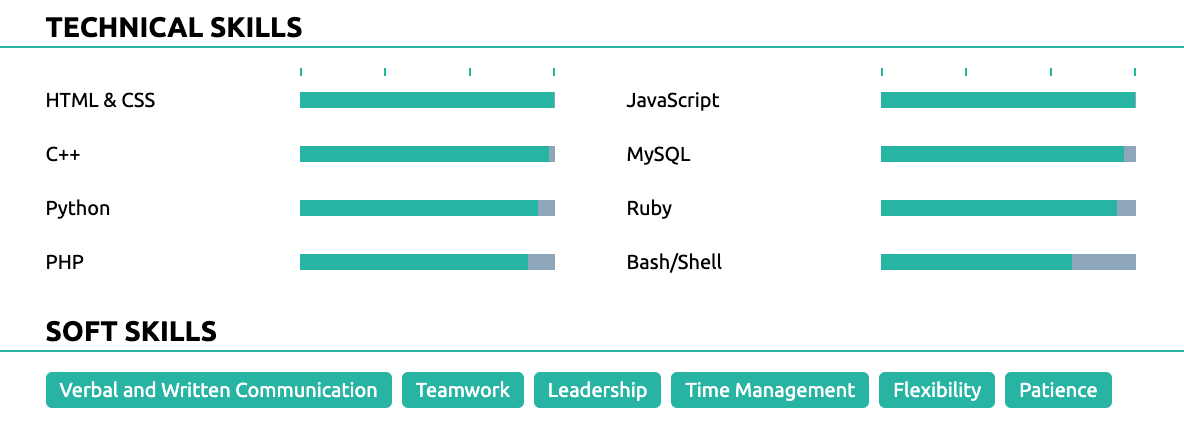
Now, let’s discuss how you should list your most important skills on your resume.
There are a few essential steps you need to follow:
Always List Hard and Soft Skills Separately
Your resume should be easy and neat to navigate. The hiring manager shouldn’t have to waste time looking for a specific skill because you didn’t separate it into the appropriate subsection.
So, just create separate categories for your hard and soft skills.
Depending on your field, you could customize the name of your “hard skills” subsection to something like “technical skills," “marketing skills," or something else related to your field.
Let’s look at an example of what skills look like on a project manager’s resume :
Methodologies & Tools
- Agile Methodology
- SCRUM Framework
- Waterfall Project Management
- Microsoft Project
- Critical Path Method (CPM)
- Earned Value Management (EVM)
- Risk Management
Soft Skills
- Team Management
- Conflict Resolution
- Negotiation
Tailor Your Skills to the Job
You might have some awesome skills, but the hiring manager only needs to know about the ones that are relevant to the job.
For example, if you’re applying for a job as an accountant, your gourmet chef skills shouldn’t be on your resume.
Look at the job ad and list at least two to three essential skills you have that are required for the role. Remember—there’s no need to list every skill you have here; just keep it relevant.
Qualifications:
- Bachelor’s degree or higher in Graphic Design or a related field.
- Tech-savvy, with some background in CMS systems such as WordPress.
- Thrives in a stressful environment and juggles multiple tasks and deadlines.
- Strong organizational and time management skills.
- Excellent communication skills.
- Self-reliant, with the ability to manage their own work.
- A can-do attitude and an outside-the-box thinker.
- Proficient in Adobe Photoshop, InDesign, Illustrator, Keynote, and Pages.
- Basic understanding of Office software such as Microsoft Word, Excel, PowerPoint, and Outlook.
So, the must-have hard skills here are Photoshop, InDesign, Illustrator, Keynote, and Pages. Other good computer skills to have are WordPress or similar CMS systems.
While you can also mention Word, Excel, PowerPoint, and Outlook, it’s pretty much assumed that you know how to use them since they’re required for most office jobs.
List Hard Skills with Experience Levels
For each hard skill you list on your resume, you should also mention your proficiency level. This tells employers what they can expect from you and how much training you might need.
- Beginner. You have some experience with the skill, whether it’s from some entry-level practice or classroom education.
- Intermediate. You’ve used the skill in a work environment with good understanding.
- Advanced. You’re the go-to person for this skill in your office. You can coach other employees, and you understand the skill at a high level.
- Expert. You’ve applied this skill to more than a handful of different projects and organizations. You’re the go-to person for advice about the skill, not just in your office but even amongst some of the best professionals in your field.
Just make sure to never lie about your actual skill level. Even if you get the job, once you need those skills you exaggerated, it will be pretty awkward for both you and your employer.
Include Transferable Skills
These are the types of skills that are useful for almost any job out there.
Transferable skills can be both soft skills (e.g.: teamwork, creativity, problem-solving skills, and others) and hard skills (MS Office Suite, HTML, writing, etc.)
Whatever job you’re applying to, chances are you have transferable skills from your experience that can come in handy one way or another. So, feel free to include them, even if they’re not specifically required for the position.
Not sure which skills to mention on your resume for your specific field? Check out our list of 101+ essential skills for inspiration!
#7. Leverage Optional Resume Sections
The sections we’ve covered so far are must-haves for any resume. They’re the bread-and-butter for any job application, and if you get them right, you’ll land any job you apply to.
But if you have some leftover space, there are a few optional sections you can choose from to give your resume a boost!

Are you bi-lingual? Or even better – multi-lingual? You should always mention that on your resume!
Even if the position doesn’t require you to know a specific language, it can still come in handy at some point. At the end of the day, it’s always better to know more languages than less.
To list languages in your resume , just write them down and assign them the appropriate level:
- Intermediate
You can also use the Common European Framework of Reference for Languages (CEFRL) or the American Council on the Teaching of Foreign Languages (ACTFL) proficiency scales.
As a given, you should never lie about your language skills. You never know—your interviewer might turn out to be fluent in the language or even be a native speaker!
Hobbies and Interests
If you want to spice up your resume, hobbies and interests could be just what you need.
While this section isn’t a game-changer, it can help the hiring manager see who you are as an individual.
For example, if you listed “teamwork” as one of your skills, hobbies like team sports can back up your claim.
And who knows? Maybe you and your interviewer have some hobbies or interests in common!
Volunteering Experience
If you’re the type of person who devotes their free time to helping others while expecting nothing in return, chances are that you’re the type of employee who’s in it for more than just the money.
Seeing volunteer experience on your resume tells hiring managers that you’re a loyal employee who’s after something meaningful.
Several studies show that listing your volunteer experience can boost your chances of getting hired, especially if you have little to no work experience.
Certifications
Hiring managers love candidates who invest in themselves, and that’s exactly what they see when you list certifications on your resume .
If you value continuous learning and strive to expand your skill set, that’s always a plus.
Certifications can also show employers how much expertise you have.
For example, if you’re a Microsoft Cloud Engineer and you specialize in Microsoft Technologies, you should definitely include all essential certifications on your resume, such as the Azure Solutions Architect Expert one.
Awards and Recognitions
There’s no harm in showing off a little on your resume. After all, you want to be a candidate that shines above the rest.
So, if you’ve received any awards or recognitions that make you stand out in your field, make sure to add them.
For example, if you’ve been recognized for your contributions to data science or received a hard-to-come-by scholarship , mention it in your resume. Just keep your entries here relevant to the field you’re applying to.
Publications
Whether you’re a freelance writer or a distinguished academic, publications are always impressive.
If you have any published works (online or in an academic journal), you can add them to your resume. Just make sure to include a link so the hiring manager knows where to check your work!
Are you looking for a career in academia? Check out our guide to writing the perfect academic CV to get started!
Working on side projects can show off your passion for your field. Whether they’re university class projects or part-time entrepreneurial endeavors, they’re relevant.
For example, if you worked on a mock software product as part of a university competition, it shows you went through every step of product creation, from ideation to creating a marketing strategy.
This project also shows off your organizational skills , and if you mention it in your resume, you stand a better chance of landing the job you had your sights set on.
But projects can also be personal, not academic. For example, you might manage an Etsy store where you sell hand-made arts and crafts to customers online. This is a great opportunity to highlight your creativity, management, and customer service skills .
Overall, hiring managers love employees who do cool work in their free time, so projects are always a great section to add to your resume.
Looking to kickstart your career? Check out our guide on how to get an internship for useful tips and real-life examples!
Extracurricular Activities
Every college freshman knows that extracurricular experience can make a difference in their application.
Especially if you don’t have a lot of experience outside of school, extracurricular activities are a great way to show potential employers your skills and give them insight into you as a person. Different clubs and after-school projects can help you gain real-life skills and considerably increase your chances of landing your first job after college.
For example, joining a student government organization can hone your leadership skills and teach you how to work as part of a team.
For example, if you’re part of a student government or public speaking club, these activities can help you hone your leadership and presentation skills.
11+ Expert Resume Tips
You’ve got the gist of how to make a resume. Now, it’s time to make it really stand out from the crowd!
Follow these exclusive resume tips to take your resume game to the next level:
- Match the professional title underneath your name to the job title of the position you’re applying for. Hiring managers often hire for several roles at once, so giving them this cue about what role you’re after helps things go smoother.
- Mention any promotions from your previous jobs. Use the work experience entries for them to focus on the achievements that helped you earn them.
- Describe your achievements using Laszlo Bock’s formula : accomplished X as measured by Y by doing Z . This way, your work experience can go the extra mile and show the hiring manager what you can bring to the table.
- Always list your achievements and responsibilities in concise bullet points. This makes your resume more reader-friendly, and it’s more likely that the hiring manager will see your impressive achievements at a glance.
- Don’t use personal pronouns like “I” or “me,” and don’t refer to yourself by name. Stick to a slightly altered third person, like “managed data integrity at XYZ Inc.” instead of “he managed data integrity at XYZ Inc.”
- Name your resume sections correctly, or it might get rejected by the ATS. Swapping out quirky names like “career history” or “expertise” for “work experience” and "skills" makes it easier for the hiring manager to find what they’re looking for, too.
- Prioritize important keywords instead of adding all of them. Make sure the relevant skills, qualifications, and experiences you add all make sense in context, too. Your goal is to get past the ATS and impress the hiring manager.
- Focus on transferable skills if you don’t have a lot of relevant work experience. Any extracurricular activities or personal projects can help you stand out here.
- Add a strategic pop of color to headings, bullet points, or key elements you want to highlight. It can help your resume stand out, but don’t overdo it—you want the information to be more impressive than the color palette.
- Don’t include the line “references available upon request.” Hiring managers already know they can request a list of references from you, so there’s no need to waste valuable space on it.
- Make sure your resume is optimized for mobile viewing. Most hiring managers use their mobile phones as often as desktop computers, so save your resume to a PDF file and make sure your formatting stays intact across any device.
- Rename the resume file you plan to send so it includes your name and the name of the position you’re applying for. It’s a small detail that can turn into a crucial mistake if you forget it.
- Read your resume out loud when you’re done. This is a great way to catch awkward phrases or spelling mistakes you might have missed otherwise.
- Use a tool like DocSend to track your resume. You’ll get a notification any time someone opens your resume, and you can see how long they spend reading it.
FREE Resume Checklist
Are you already done with your resume? Let’s see how it holds up!
Go through our checklist for perfecting your resume and see where you stand!

If you missed some points, just go through your resume one more time and perfect it.
And if you ☑’d everything—congrats! You’ve learned all there is to know about writing a resume, and you’re good to go with your job search.
Need to write a CV instead of a resume? Check out our step-by-step guide on how to write a CV with dozens of examples!
9 Resume Templates for Different Industries
Looking to create an effective resume without dealing with the formatting hassle? Just choose one of the templates below.
#1. Traditional Resume Template

Good for traditional industries like finance, banking, law, and manufacturing.
#2. Modern Resume Template

Good for both contemporary and forward-looking industries, including entrepreneurship, medical technology, and engineering.
#3. Creative Resume Template

Good for creative industries, including entertainment, design, and architecture.
#4. Minimalistic Resume Template

Good for experienced professionals in basically any industry who want to let their achievements do the talking.
#5. IT Resume Template
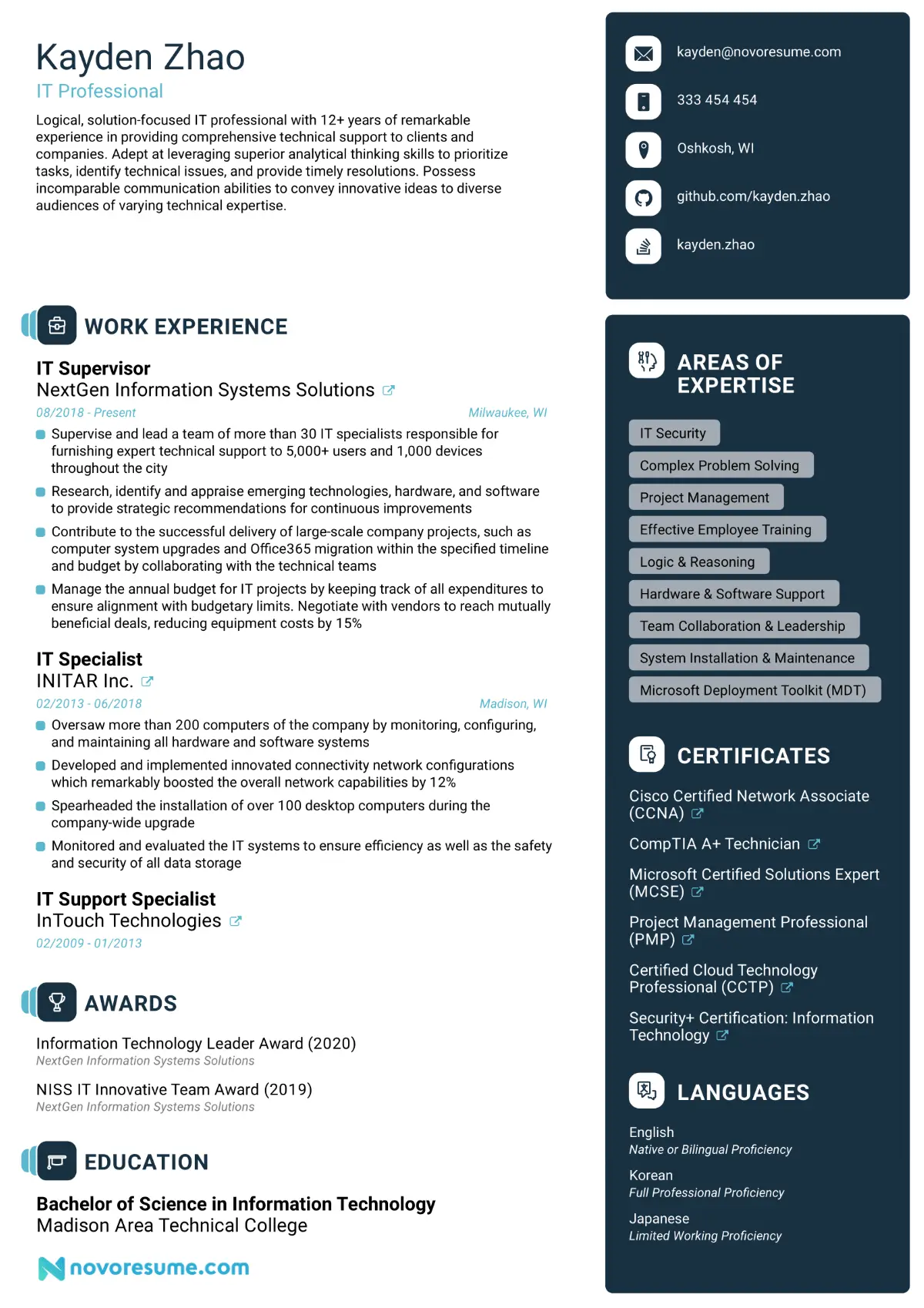
Good for any IT-related profession like software development, cyber security, and DevOps engineering.
#6. Tech Resume Template
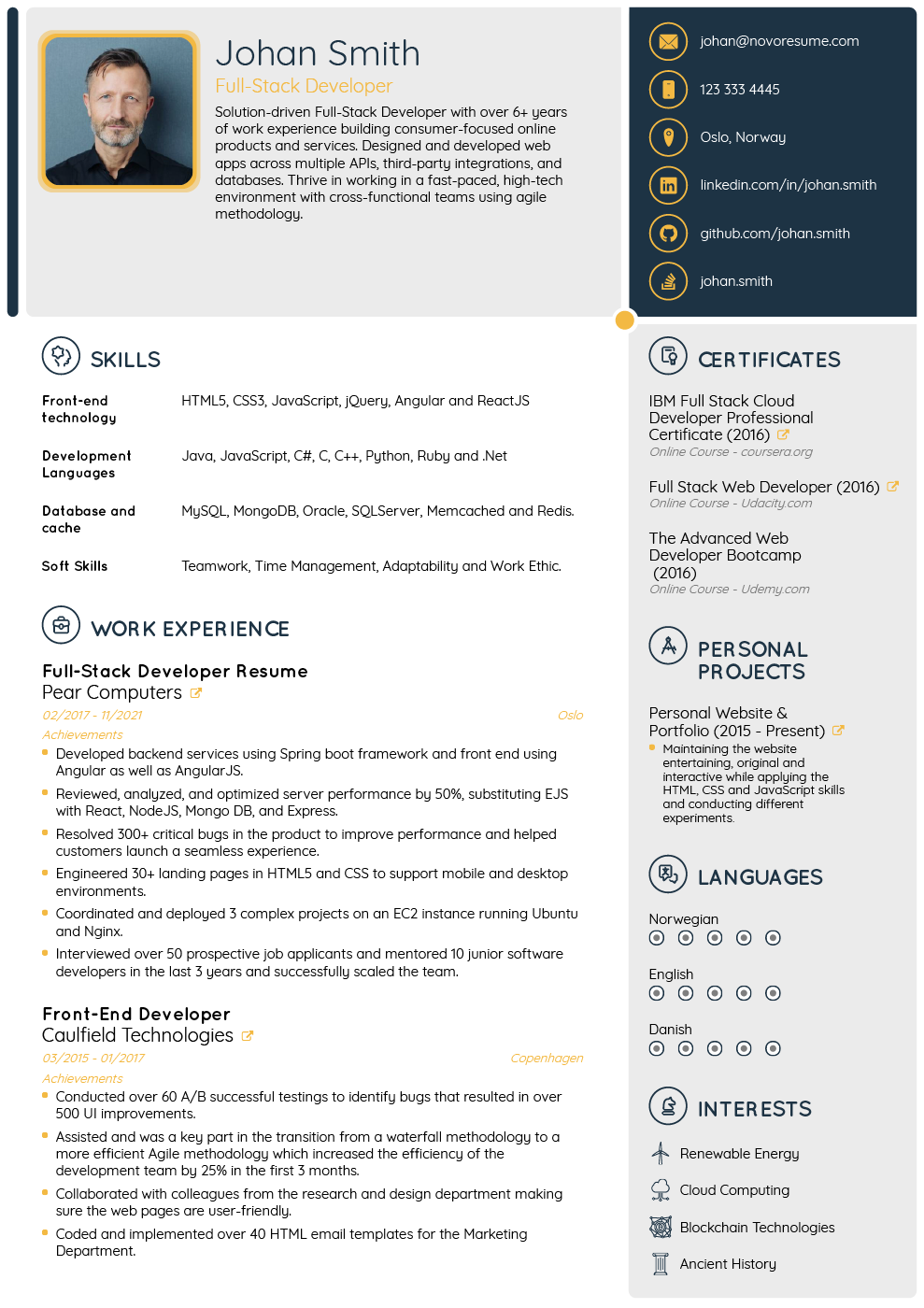
Good for the tech industry and everything it encompasses.
#7. College Resume Template

Good for college students and recent graduates alike.
#8. General Resume Template

Good for multiple industries, including HR, education, and customer service.

#9. Executive Resume Template

Good for senior professionals across different industries, including hospitality, marketing, and logistics.
17+ Resumes for Different Jobs
Knowing how to write a resume is one thing, but making a resume that stands out is something entirely different. Without inspiration, even top career experts might stumble on a roadblock or two.
Check out the following effective resume examples for specific jobs to get a better sense of what a good resume looks like:
#1. Nurse Practitioner Resume Example

Check out our full guide to writing a nurse resume here.
#2. Data Scientist Resume Example

Check out our full guide to writing a data scientist resume here.
#3. Business Analyst Resume Example

Check out our full guide to writing a business analyst resume here.
#4. Digital Marketing Resume Example

Check out our full guide to writing a digital marketing resume here.
#5. Software Engineer Resume Example

Check out our full guide to writing a software engineer resume here.
#6. Construction Project Manager Resume Example

Check out our full guide to writing a construction project manager resume here.
#7. Customer Service Resume Example

Check out our full guide to writing a customer service resume here.
#8. High School Resume Example

Check out our full guide to writing a high school resume here.
#9. Student Resume Example

Check out our full guide to writing a student resume here.
#10. Server Resume Example

Check out our full guide to writing a server resume here.
#11. Actor Resume Example

Check out our full guide to writing an actor resume here.
#12. Web Developer Resume Example

Check out our full guide to writing a web developer resume here.
#13. Engineering Resume Example
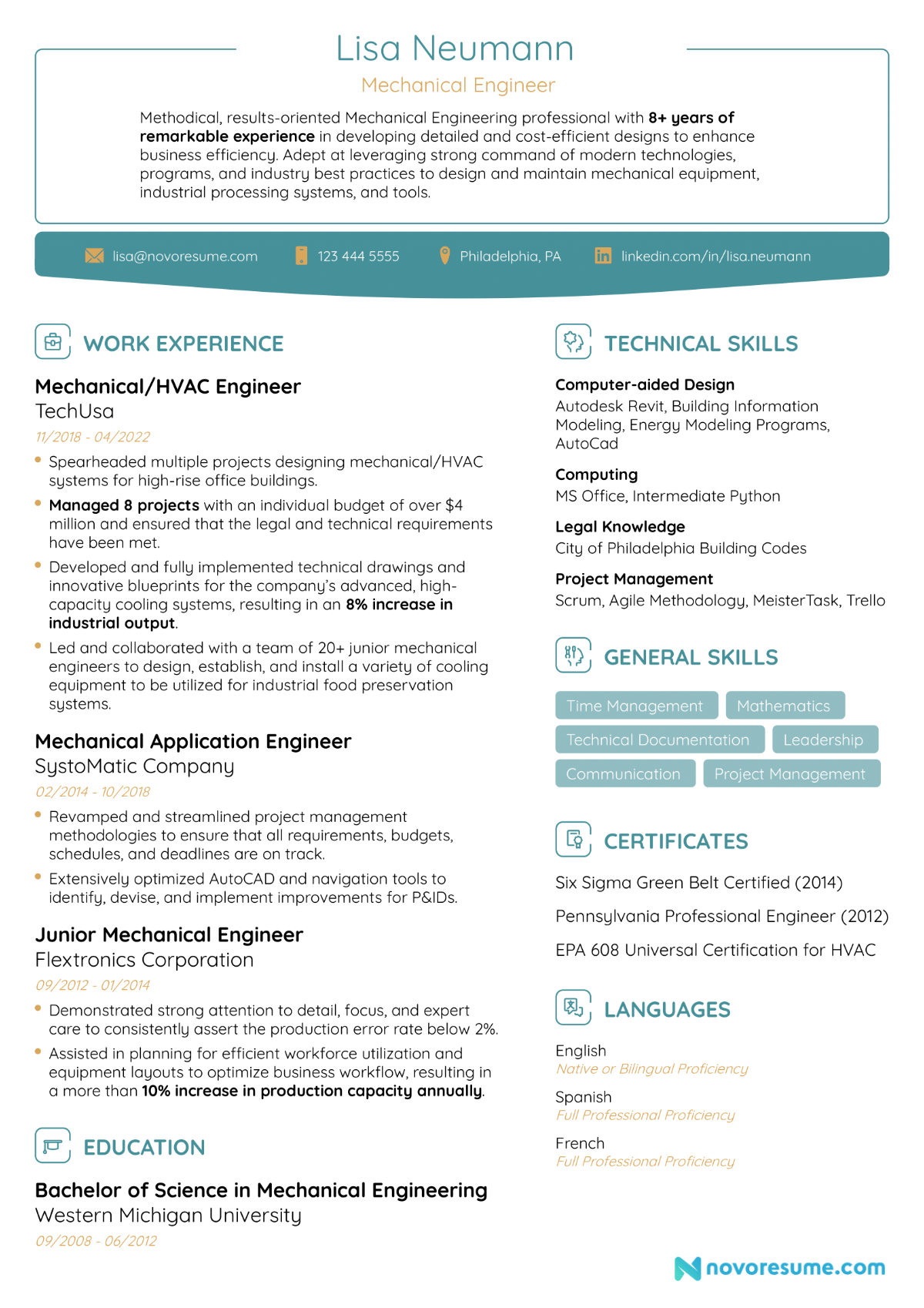
Check out our full guide to writing an engineering resume here.
#14. Computer Science Resume Example

Check out our full guide to writing a computer science resume here.
#15. Architect Resume Example

Check out our full guide to writing a data analyst resume here.
#17. Remote Job Resume Example

Check out our full guide to writing a remote job resume here.
#18. Sales Associate Resume Example

Check out our full guide to writing a sales associate resume here.
#19. Receptionist Resume Example

Check out our full guide to writing a receptionist resume here.
Want to see more examples? Check out our compilation of 80+ resume examples for different fields .
- Administrative Assistant Resume
- Bartender Resume
- DevOps Engineer Resume
- Executive Assistant Resume
- Flight Attendant Resume
- Graphic Designer Resume
- Paralegal Resume
- Pharmacist Resume
- Recruiter Resume
- Supervisor Resume
Next Steps After Your Resume
Now that we’ve covered everything you need to know about how to make a resume, it’s time to talk about the rest of your job application.
After all, your resume is only the first step in your job search. To land the job you deserve, you also need to write a captivating cover letter and ace that upcoming interview. Here’s how:
#1. How to Write a Convincing Cover Letter
The companion piece to every resume is the cover letter.
Most job-seekers flinch when they hear that they have to write a cover letter. What do you even mention in a cover letter, anyway? If you were good at writing cover letters, you’d be applying for a job as a writer !
In reality, though, writing a cover letter is very simple once you know its purpose.
Think of your cover letter as a direct message to the hiring manager. It’s your chance to briefly explain why you’re such an awesome fit for the position. And with a few cover letter tips to point you in the right direction, you’ll write the perfect cover letter for your job application.
Just follow this structure:

- Add the contact details. Include the same contact information as on your resume, plus additional contact details for the hiring manager, including their name, job title, the company’s name, and location.
- Introduce yourself. Start your cover letter by mentioning who you are, what your work experience is, and why you’re interested in the position. Mention a standout achievement or two, relevant skills, and what you’d like to do for the company you’re applying for.
- Explain why you’d excel at the job. Find the requirements in the job ad that you meet, and elaborate on how you fulfill the most important ones. Research the company so you know what you like about it, and mention it in your cover letter. Make sure to convey your enthusiasm for the job and confidence that you’ll be a great fit for their team.
- Wrap it up politely. Conclude your cover letter by recapping your key selling points and thanking the hiring manager for their time. Then add a call to action, such as “Please don’t hesitate to reach out to me at the provided phone number so that we can discuss my application in greater detail.” Then, add a closing line and follow it with your full name.
Sounds easy, right? Here’s a real-life example to drive the point home:
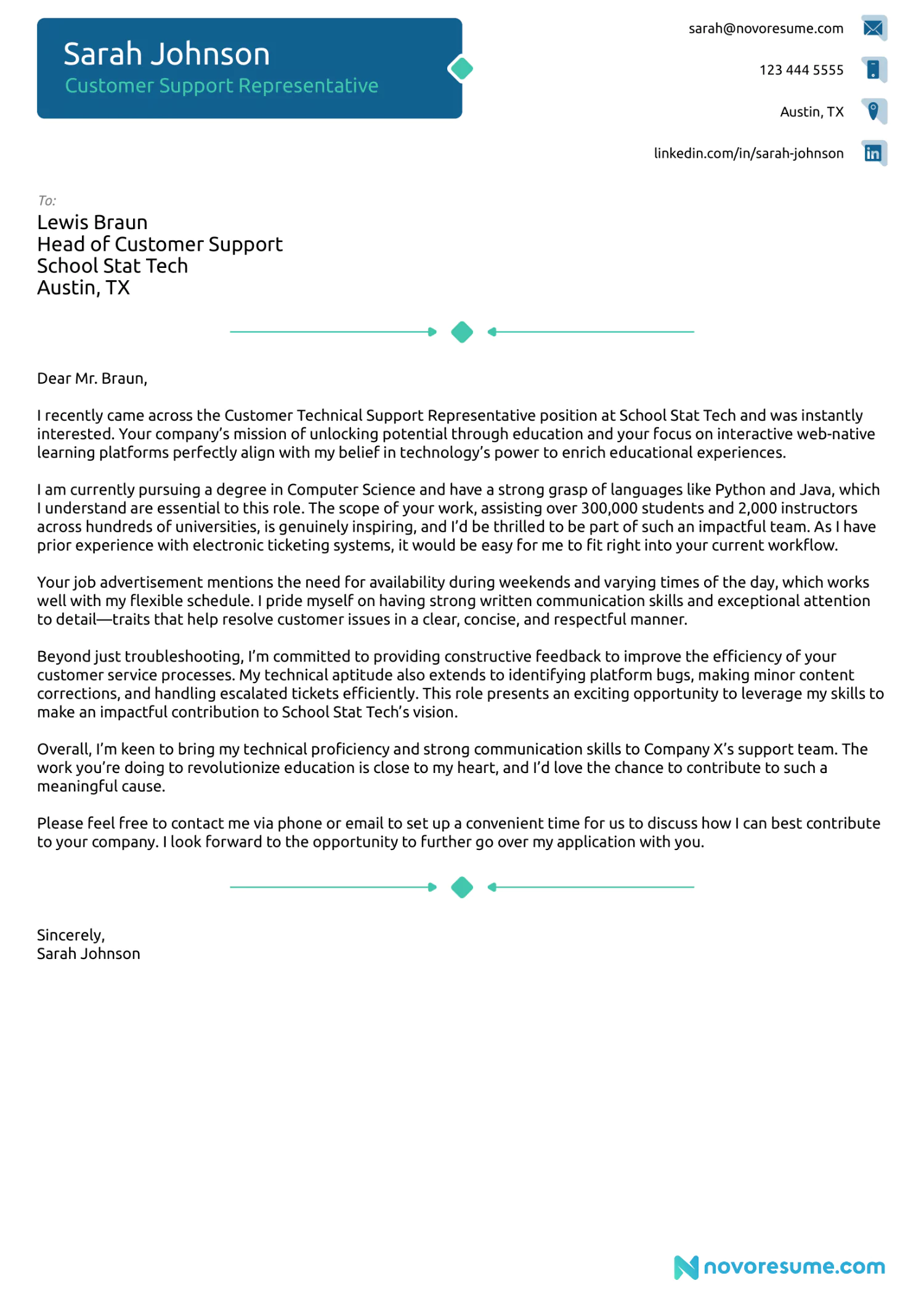
Do you need more help perfecting your cover letter? Learn what the most common cover letter mistakes are and check out cover letter examples for all professions here.
#2. How to Ace Your Next Interview
Once you’ve perfected both your resume and cover letter, there’s only one thing left.
It’s time for the final step—the dreaded job interview.
Whether you’re an extrovert or an introvert, you probably hate the interviewing process. No matter how experienced you are, it can be nerve-wracking. Sitting there while someone’s prodding into your past experiences and judging you isn’t fun.
But did you know that most interviewers ask the same questions?
That’s right—all you have to do is learn how to answer some of the most common interview questions, and you’ll be an interview away from landing your dream job!
Just check out our complete guide to the 35+ Job Interview Questions and Answers and learn how to ace your next interview.
FAQs on How to Make a Resume
Do you still have some questions about making a resume? Check out the answers to the most frequently asked questions below!
#1. What does a good resume look like in 2024?
For your resume to look good in 2024, make sure it’s organized and clean and isn’t longer than one page.
Be sure to include information that adds value to your application—leave out the focus on your relevant work experience and skills that you can back up, and list as many achievements as possible.
If you’re using a resume template, choose one based on your industry. Conservative industries like law, banking, and business require more traditional resume templates. But if you’re going for an industry like design, architecture, or marketing, you can go for a creative resume template .
Remote work is also big in 2024, so if that’s what you’re after, tailor your resume to match the job you want.
#2. How do you make a resume in Word?
The best way to create a resume in Word is to use a pre-designed Microsoft Word template. To access them, you should:
- Open MS Word
- Click “file” from the menu bar
- Select “new”
- Type “resume templates” in the search bar
That said, Word resume templates are generic, hard to personalize, and overall not very stylish.
Want a resume that looks good and is extremely easy to make? Check out resume templates to get started!
#3. How do I write a resume for my first job?
If you’re writing your first-ever resume for an entry-level position, the hiring manager won’t expect you to have any work experience.
However, you can make up for your lack of experience with your skills and academic achievements.
For example, you can take advantage of extracurricular activities, internships, volunteering experiences, and other non-professional experiences. You can use them to highlight the skills you’ve gained and what you’ve achieved so far.
So, your first job resume should have a resume objective, emphasize your education, and replace your work experience with any internships, volunteering, independent projects, or other experiences.
#4. How to make a resume on Google Docs?
You can make a resume on Google Docs by choosing one of their templates and filling it in on the go.
All you have to do is go to your Google Drive’s template gallery, choose your preferred template, fill in your information, and your Google Docs resume is ready to go!
That said, Google Docs templates aren’t the most user-friendly choice. You don’t have much flexibility with the layout and formatting isn’t that easy. For example, you tweak a section to the slightest, and the whole resume becomes a mess.
If you want an easier option, check out our resume builder !
#5. What kind of resume do employers prefer?
Typically, employers prefer one-page-long resumes that follow the reverse chronological format.
Hiring managers receive hundreds of resumes every day, so they don't have the time to read three-page resumes. Try one of our one-page resume templates so you don’t go over the recommended resume length.
Meanwhile, the reverse-chronological format is the most popular because it draws attention to your most recent jobs and professional achievements, which is the #1 most important thing hiring managers look at when evaluating a resume.
#6. How many jobs should you put on your resume?
You should only include relevant job positions on your resume.
This means that your work experience section should be tailored to the job you are applying for. If you’ve worked five different jobs and they can all add value to your current application, then you should include all five.
If, on the other hand, you’re applying for, say, a customer service position and some of your past jobs don’t have anything to do with customer service, you should skip them.
#7. Should I put my address on my resume?
You can put your location (city, state, or country) on your resume, but you don’t need to put your entire physical address.
Putting a physical address on a resume was the norm back when companies would contact you via mail. In today’s world, everyone communicates via email, which is why adding a correct and professional email address to your contact information section is far more important than putting your physical address.
So, just include your location or-–if you’re a remote worker—specify you prefer to work remotely by writing “working remotely from [location].”
#8. What information should I leave out of my resume?
As a general rule, you shouldn’t include your birthday or your headshot on your resume. This norm varies from country to country but it applies to the USA, Canada, and UK.
If you have plenty of achievements to list under your work experience, then you can leave your basic work responsibilities out of your resume.
In your education section, you should only include your highest and most recent degree. So, if you hold a Ph.D., you can list that and your Master’s degree and leave your Bachelor’s degree and high school diploma out.
Finally, leave out any skills that aren’t relevant to the job you’re applying for.
#9. Is a resume a CV?
Depending on where you are, a CV (Curriculum Vitae) and a resume might be completely different things.
In most of the world, though, including Europe and Asia, they are used interchangeably for the same document. Both CVs and resumes are one to two pages long, and list skills and experiences relevant to the position you’re applying for.
Sometimes more detailed resumes that go over one page are referred to as CVs. These are typically only used by senior professionals, executives, CEOs, etc.
In the USA, however, a CV is a completely different document. Typically, CVs are detailed and comprehensive documents that highlight your entire academic and professional history. They’re often used for academic, scientific, or research positions, which is why this type of CV can also be referred to as an academic CV.
You can create your CV using one of our CV templates !
#10. Should I write my own resume?
Yes, you should always write your own resume.
Your resume is your opportunity to show the hiring manager your communication, writing, and presentation skills . Employers also evaluate you based on how effectively you can convey information about yourself, and there’s no one that can represent you better than yourself.
Writing your own resume lets you introduce yourself authentically. You have the best understanding of your skills and experiences, and you can personalize them to make your resume stand out.
And, as a bonus, the experience of writing your resume yourself can be reflective and insightful, so it might help you understand your professional journey and career goals better.
#11. Can a resume be two pages?
Generally, we strongly recommend that your resume stick to one page.
Hiring managers go through hundreds of resumes every day, and keeping your resume to one page increases the odds that they’ll see your qualifications faster.
In some cases, like when you have a lot of relevant experience, your resume can go over two pages. But this exception is reserved for senior professionals with over a decade of relevant experience and tons of skills and achievements that simply can’t fit on one page.
#12. Is a simple resume okay?
Absolutely, a simple resume is often more than okay—it's preferable.
Before your resume even gets to the hiring manager, a complicated layout could get it rejected by the applicant tracking system (ATS). A simple resume template can help get your application straight to the hiring manager.
A clean layout can also make sure that your resume is easily readable and looks professional. This can focus the hiring manager's attention on your work experience and skills without excessive clutter or flashy colors to distract them.
Key Takeaways
And that’s a wrap!
If you’ve followed all of our advice until now, congrats! You’re probably an expert on how to make a resume.
To recap, let’s go through some of the most important lessons we’ve learned so far...
- Use the right resume builder to make the process as smooth as possible. You don’t want to mess around with formatting for hours before even starting to work on your resume!
- Focus on your achievements over responsibilities. This can help you stand out from all the other applicants, especially if you back your claims up with data.
- Include all the must-have sections, like the resume summary, work experience, education, and skills. Then leverage optional sections if you have leftover space.
- Tailor your resume for the job you’re applying for. Everything listed on your resume should be relevant to the specific job you’re applying for, and you should write a new resume for every new job application.
- Take the time to perfect your cover letter. It’s just as important as your resume, so make sure you pay as much attention to it!

To provide a safer experience, the best content and great communication, we use cookies. Learn how we use them for non-authenticated users.
Resume Maker:AI resume builder 17+
Job curriculum vitae creator, laszlo mile, designed for ipad.
- 4.6 • 33 Ratings
- Offers In-App Purchases
Screenshots
Description.
Our resume builder app makes it easy to create a professional-looking resume that will impress potential employers. With a variety of customizable templates to choose from, you can create a resume that highlights your skills and experience in just minutes. Our app also includes expert tips to help you make the most of your resume, such as how to optimize keywords and showcase your accomplishments. In addition to its easy-to-use interface, our app offers features like a built-in spell-checker and the ability to save your resume in multiple formats, including PDF and Word. You can also share your resume directly from the app with potential employers or colleagues. With our app, you can take the first step towards landing your dream job. Whether you're a recent graduate or an experienced professional, our app has everything you need to create a winning resume. Download now and start building your future today.
Version 2.2.3
Ratings and Reviews
I managed to create my resume very easy and fast.
Amazing app, super for my iPhone 13 Pro, thanks
Waste of time
Can’t download or share a pdf if the resume you created because when you try to do that,it redirects you to paying for the Pro version!!!
App Privacy
The developer, Laszlo Mile , indicated that the app’s privacy practices may include handling of data as described below. For more information, see the developer’s privacy policy .
Data Linked to You
The following data may be collected and linked to your identity:
- Contact Info
Data Not Linked to You
The following data may be collected but it is not linked to your identity:
- User Content
- Identifiers
- Sensitive Info
Privacy practices may vary, for example, based on the features you use or your age. Learn More
Information
- Weekly Plan $3.99
- Monthly Plan $6.99
- Yearly Plan $17.99
- Proof reading $24.99
- Developer Website
- App Support
- Privacy Policy
More By This Developer
Curly Girl Method
PhotoBoost-Background Removal
e-cards: Invitation & RSVP
My Toilet Finder
Quick Memos
You Might Also Like
CVHub: Resume Builder, Creator
Broker xChief - Trading
ChatAssist: Ask AI Chat Bot
GPT Voice Chat & AI Writer
Resume Builder - My Resume
Car Insurance Quotes: Thrifty

An official website of the United States government
Here's how you know
Official websites use .gov A .gov website belongs to an official government organization in the United States.
Secure .gov websites use HTTPS A lock ( Lock Locked padlock ) or https:// means you've safely connected to the .gov website. Share sensitive information only on official, secure websites.
How to complete any task on USAJOBS, step by step.
Manage Account
- Create a login.gov account
- Use login.gov if you have limited access to a phone or cell service
- Change the phone number you use to sign in
- Enter an international phone number when creating a login.gov account
- Update your primary email address
- Change or reset your password
- Sign into your account if you can't access your primary email
- Create a profile
- Delete a profile
- Fill out your education
- Answer questions about federal service
- Choose hiring paths in your profile
- Add languages in your profile
- Answer questions about military service
- Fill out your work experience
- Make your resume and profile searchable
Job announcement
- Understand a job announcement
- Understand announcement closing types
- Save a job announcement
- Remove a saved job announcement
- Contact an agency
Application
- Create an application
- Save an application
- Update an application
- Continue an application
- Check on the status of an application
- Archive an application
- Cancel an application
- View job applications
- Create a resume
- Build a resume
- Edit a resume
- Upload a resume
- Make a resume searchable
- Print a resume
- Upload documents
- Manage documents
- Fax documents
- Search by your preferences
- Save a search
- Sort search results
- Understand search results
- Unsubscribe from a saved search
Filter results by...
- Appointment type
- Hiring path
- Mission critical career field
- Security clearance
- Travel percentage
- Work schedule
- Zero job openings
Keyword and location
Get started.
USAJOBS posts all federal job opportunities with a position description and instructions how to apply. With USAJOBS.gov tools and resources, you can find the right federal job faster.
About USAJOBS
As the federal government's official employment site, USAJOBS has attracted over 16 million job seekers to create accounts to date.
Skip to Content
Other ways to search:
- Events Calendar
5 things to do this summer for a successful job search

1. Work on your resume
A resume is the most common document requested when applying for a job. If you are networking or interested in an opportunity, having a well-crafted resume ready to go will benefit you.
Build a resume showcasing your skills and experience. For each highlighted skill, back it up with specific details. Your resume is an opportunity to sell yourself to potential employers. Be sure to include accurate and detailed information to help you stand out, and tailor your resume for each job application.
Career Services offers AI Resume Editor by Quinncia , a free online resume review tool to help students enhance their resumes. The tool uses AI technology to provide personalized feedback on your resume based on criteria gathered from employers and global best practices.
2. Create a template cover letter
A tailored cover letter can be the most vital piece of an application. The cover letter lets you elaborate on why you are applying to this specific role. A well-written cover letter will connect your reasons to your experiences and skills, showing why you are the ideal candidate for the position.
While you won't be able to finalize a cover letter until you find a position you're interested in, you can develop a template cover letter as a starting point. You can build the template around the foundational skills you hope to use in a future role or the experiences you've gained that are relevant to positions you're interested in.
3. Update your online profiles
Online profiles are essential for finding a job or internship. In fact, Handshake is the place where many college students find jobs.
Keep your online profiles, like Handshake and LinkedIn , up to date. You’ve likely expanded your skills and added experiences over the last year. Take time this summer to review your profiles and update them with any new information:
Consider classes, part-time work, leadership roles and other experiences you could add to enhance your profile.
Rewrite and update your summary section on LinkedIn with your goals, projects and interests.
Update your profile image with a recent professional photo. Career Services offers a free self-service photo booth you can use if you need a new profile photo!
4. Build an online portfolio
For relevant majors and job positions, an online portfolio gives you a way to highlight your work and projects. Some positions may ask you to submit a portfolio with your application. Even when it’s not required, you may still want to provide the link to your portfolio in your resume or cover letter.
Students can create a free online portfolio using BuffsCreate .
5. Prepare for recommendation and reference requests
Summer can be a great time to connect with mentors, discuss your professional goals and ask for recommendations or references. While past professors, supervisors and volunteer coordinators are excellent resources, anyone who can reflect on your skills and professional identity can make a good reference.
Prepare for the job search
Take time this summer to get a head start on your job or internship search. Career Services offers career counseling, on-demand tools and more to support students.
- SUGGESTED TOPICS
- The Magazine
- Newsletters
- Managing Yourself
- Managing Teams
- Work-life Balance
- The Big Idea
- Data & Visuals
- Reading Lists
- Case Selections
- HBR Learning
- Topic Feeds
- Account Settings
- Email Preferences
4 Resume Mistakes to Avoid When You Don’t Have Much Experience
- Irina Cozma

A good resume can set you apart and help you land that interview.
Understanding the common mistakes job candidates make on resumes, and how to overcome them, can set you apart from your competitors. The first mistake is including irrelevant work experience. Instead, only add roles that are relevant to the position you’re applying for. The second is customizing your resume. While it’s in your benefit to adjust your resume to better match the job description, over-tuning your resume for every application can be a waste of time — and end up slowing down your search. This is especially true if you’re focused on securing a particular position that has a standard job title like “marketing coordinator” or “sales associate.” The third is overdesigning your resume. Recruiters only spend a few seconds scanning it, so keep the format simple and straightforward. The fourth is coming off as a novice. For example, don’t use an ancient email address — update it to something that sounds more professional, and give your resume a specific name so it’s easier to identify.
Resumes. Love them or hate them, you will probably need one when you apply for a job. The resume has a specific tactical role to play in your search — to get you the interview. You need to make sure it checks a few boxes to do that work because, even if you take advantage of your network, sooner or later, you will need to share your resume with the hiring manager.
- Irina Cozma , Ph.D., is a career and executive coach who supports professionals to have better career adventures. She coached hundreds of Fortune 500 executives from global organizations like Salesforce, Hitachi, and Abbott. Irina also coaches startups and the Physicians MBA at the University of Tennessee. Download her free career guide to help you prepare for your next career adventure.
Partner Center

COMMENTS
VisualCV, Kickresume, and Novoresume are also among some of the best resume builder websites to help you put up a resume in a short time. 2. Use a Resume Builder App. These days, you can find a mobile app for almost everything you can do online, and resume-building apps are not an exception.
Create a resume for free, easily. Pick a template, use built-in content, and download with one click. Tools. Resume Builder Create a resume in 5 minutes. Get the job you want. ... That makes it way easier to tailor your resume for each job offer you're applying for in less than 5 minutes. Now you don't have to mass-send the same resume or ...
Direct application. Once your resume is complete you can apply for jobs directly on the Indeed platform. 3. Zety. Zety's mobile site is another simple option to make a resume on your iPhone. You upload an existing resume and the site will extract the information to build a foundation for your new, up-to-date resume.
Yes, you can make a resume on your phone. However, creating a resume on the mobile versions of Microsoft Word, Apple's Pages, or Google Docs isn't a user-friendly experience because typing and formatting are more difficult, and spotting typos is difficult on a small screen. The best way you can make a resume on your phone is to use a ...
The Job And Resume AI app on Canva uses generative AI technology to help users create personalized resumes for each job application. This AI tool analyzes the information — that is, your existing resume text and the job description — you provide to generate tailored suggestions for your summary and skills, experience, and cover letter.
Microsoft Word. Price: Free /In-app purchases ($1.00 - $99.99 per item) Microsoft Word is the original resume builder app. People still use this app to build a resume. The app has templates, and ...
Choose a free resume template from our library or start from scratch. Edit the text to insert your skills, background, and qualifications. Add your professional photo or logo. Include graphic elements to make your CV visually engaging. Save and download in your preferred PDF or Word format, embed online, or transform into a responsive Canva Site.
While it might not be the most convenient way to make a resume, there are at least two good solutions to create a resume on an iPhone:. Use Pages (the iPhone app). Go with an online service that allows you to fill out resume templates.; With Pages, all you have to do is pick from a collection of Pages resume templates and fill them out. If you decide to go with a reliable, professional resume ...
To make a resume online with Zety, follow these easy steps: Select the template that best suits your profession and personality. Upload your previous resume, or choose to create a brand new resume. Fill in the basic contact information fields, as well as your resume headline. Pick the best resume format for your needs.
With Canva's free resume builder, applying for your dream job is easy and fast. Choose from hundreds of free, designer-made templates and customize them within a few clicks. Forget spending hours formatting your resume, or choosing complimentary fonts for your cover letter. Creating a resume online with Canva's free resume builder will give ...
Jump start your resume with resume templates. Don't create your resume from scratch. Use one of our proven resume templates and kick start your search from the beginning. Create your resume in minutes with Indeed's free resume builder. Download it to your computer or use it to apply for any job on Indeed.
Set the correct font size. As a rule of thumb, go for 11-12 pt for normal text and 14-16 pt for section titles. Use a PDF file. Always save your resume as a PDF file, unless the employer specifically requests otherwise. Word files are popular, but there's a good chance they'll mess up your resume's formatting.
Here's how you can optimize your resume creation using mobile devices. Powered by AI and the LinkedIn community. 1. Mobile Basics. Be the first to add your personal experience. 2. Cloud Access. Be ...
In this video, you will learn how to make a resume in a simple and easy way by using your mobile phone. This video is helpful in making a resume using a mobi...
Example: "Achieved goal of reaching 250% annual sales quota, winning sales MVP two quarters in a row.". Be brief. Employers have mere seconds to review your resume, so you should keep your descriptions as concise and relevant as possible. Try removing filler words like "and," and "the.".
Business. Your business resume should be structured cleanly, use formal colors, and be loaded with professional achievements. The following business resume examples show you how it's done. Human Resources (HR) 6. Entry Level HR Resume. HR Business Partner Resume. HR Coordinator Resume. HR Generalist Resume.
How to write a mobile developer resume. When writing a resume, it's often helpful to break the process into several steps. Here are 8 steps that you can follow to write a mobile developer resume: 1. Make a plan and choose a format. Before you begin writing your resume, it might be helpful to plan your format.
Click the Me icon at the top of your LinkedIn homepage. Click View Profile. Click the More button in the introduction section. Select Build a resume from the dropdown. From the Select a resume ...
Throughout this guide, we're going to give you the tools you need to create cover letters and resumes that get results, tips that will help you ace your interviews, and information on what to do after the interview to help you land the job! Proven strategies for what to include in cover letters. Formatting for various resume styles and types.
In this video how to create a CV /Resume with your mobile phone for free. I use a very resourceful Mobile app call intelligent CV to create outstanding Res...
Generate a professional resume summary instantly, or use our AI-powered summary generator to customize your own in 2 minutes. Randomized Summary. Registered Dental Assistant with 6+ years of experience managing medical records and caring for patients. Motivated professional recognized by peers for my effective teamwork and time management skills.
In addition to its easy-to-use interface, our app offers features like a built-in spell-checker and the ability to save your resume in multiple formats, including PDF and Word. You can also share your resume directly from the app with potential employers or colleagues. With our app, you can take the first step towards landing your dream job.
Make it distinctive to highlight your name and contact information. Organize your resume sections in the following order: summary/objective, work experience, education, skills, and extras. Use bullet points for your entries under each section. Find resume icons for each section or skip them altogether. File format.
#resume #jobsearch How to make resume in mobile phone || Create your simple resume|cv with in 2 minutes in smartphoneapk link in below 👇https://play.google....
CVs, on the other hand, are more comprehensive and used for academic, research, medical and certain international job applications where detailed information is expected. The choice between using a CV or a resume depends on the industry, country and specific requirements of the job application. See what a resume looks like for additional guidance.
A mobile application developer designs and produces applications for use on a cell phone or other mobile device. They use software engineering and coding skills to create useful applications, often working on a freelance basis. If you're applying for mobile app developer positions, learning how to write an effective resume can be beneficial in showing you what details to include to attract the ...
Get started. USAJOBS posts all federal job opportunities with a position description and instructions how to apply. With USAJOBS.gov tools and resources, you can find the right federal job faster. Get started.
1. Work on your resume A resume is the most common document requested when applying for a job. If you are networking or interested in an opportunity, having a well-crafted resume ready to go will benefit you. Build a resume showcasing your skills and experience. For each highlighted skill, back it up with specific details.
Decide on a CV format and style. Before you start writing your CV, you need to format it properly. Open a new document in Microsoft Word or Google Docs and use the following settings: Set ½ - 1" margins on each side. Use a font size between 10 and 12 points. Select a professional font such as Times New Roman or Arial.
Summary. Understanding the common mistakes job candidates make on resumes, and how to overcome them, can set you apart from your competitors. The first mistake is including irrelevant work ...